REPORTS 2020
In questa sezione vengono raccolti alcuni documenti di Enti, Associazioni e Istituzioni con i dati dell’innovazione tecnologica e contenuti significativi per lo sviluppo sostenibile della società e la cultura della manutenzione industriale.
+++
In this section are collected some documents of organizations, associations and institutions with the data of technological innovation and significant contents for the sustainable development of the company and the culture of industrial maintenance.

Dicembre 2020
Horizon Europe - Presentazione (testo italiano, 57 pagine; testo inglese, 4 pagine)
Horizon Europe è il futuro programma di investimenti dell‘Unione Europea per la ricerca e l'innovazione (2021 –2027). E’ un ambizioso programma quadro che intende rafforzare le basi scientifiche e tecnologiche dell'UE e lo spazio europeo della ricerca, migliorare la capacità innovativa, la competitività e l'occupazione in Europa e conseguire obiettivi prioritari per i cittadini, sostenendo il modello socio-economico e i valori europei. La Commissione propone di stanziare un bilancio di 100 miliardi di euro per il programma.
+++
December 2020
Horizon Europe - Presentation (Italian text, 57 pages; Englis text, 4 pages)
Horizon Europe is the future investment program of the European Union for research and innovation (2021-2027). It is an ambitious framework program that aims to strengthen the scientific and technological foundations of the EU and the European research area, improve innovation capacity, competitiveness and employment in Europe and achieve priority objectives for citizens, by supporting the socio-economic model. economic and European values. The Commission proposes to allocate a budget of € 100 billion for the program.
https://ec.europa.eu/info/sites/info/files/research_and_innovation/strategy_on_research_and_innovation/presentations/horizon_europe_it_investire_per_plasmare_il_nostro_future.pdf
https://ec.europa.eu/info/sites/info/files/research_and_innovation/funding/documents/ec_rtd_horizon-europe-overview.pdf
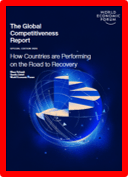
December 16, 2020
Global Competitiveness Report Special Edition 2020: How Countries are Performing on the Road to Recovery
Pub: World Economic Forum (English text, 95 pages)
The combined health and economic shocks of 2020 have impacted the livelihoods of millions of households, disrupted business activities, and exposed the fault lines in today’s social protection and healthcare systems. The crisis has also further accelerated the effects of the Fourth Industrial Revolution on trade, skills, digitization, competition and employment, and highlighted the disconnect between our economic systems and societal resilience. In this moment, it is crucial to not only reflect on how best to return to growth, but also, how to build back better economies that improve outcomes for people and the planet. This special edition of the Global Competitiveness Report provides the basis to support such deeper reflection, providing policymakers with priorities across three timeframes: those priorities that emerged from before the crisis, those priorities that are critical for the shorter term revival, and those priorities that are essential for longer term transformation for better outcomes on shared prosperity and sustainability in the future.
+++
Rapporto sulla competitività globale - Edizione speciale 2020: come i paesi stanno andando verso la ripresa
Gli shock economici e sanitari combinati del 2020 hanno avuto un impatto sui mezzi di sussistenza di milioni di famiglie, hanno interrotto le attività economiche e messo in luce le linee di frattura nei sistemi di protezione sociale e sanitario di oggi. La crisi ha inoltre accelerato ulteriormente gli effetti della quarta rivoluzione industriale sul commercio, le competenze, la digitalizzazione, la concorrenza e l'occupazione, e ha evidenziato la disconnessione tra i nostri sistemi economici e la resilienza della società. In questo momento, è fondamentale riflettere non solo su come tornare al meglio alla crescita, ma anche su come ricostruire economie migliori che migliorino i risultati per le persone e il pianeta. Questa edizione speciale del Rapporto sulla competitività globale fornisce la base per sostenere una riflessione approfondita, fornendo ai responsabili politici le priorità in tre tempi: quelle che sono emerse prima della crisi, quelle che sono critiche per il rilancio a breve termine e quelle che sono essenziale per la trasformazione a lungo termine per ottenere migliori risultati in futuro su prosperità e sostenibilità condivise.
http://www3.weforum.org/docs/WEF_TheGlobalCompetitivenessReport2020.pdf
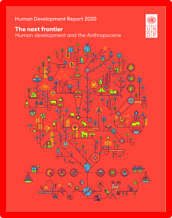
December 15, 2020
The next frontier - Human development and the Anthropocene
Pub: United Nations Development Programme (English text, 412 pages)
Hidden in the long shadow of Covid‑19, 2020 has been a dark year. Scientists have been forewarning a pandemic like this for years, pointing to the rise in zoonotic pathogens —those that jump from animals to humans — as a reflection of the pressures people put on planet Earth.Those pressures have grown exponentially over the past 100 years. Humans have achieved incredible things, but we have taken the Earth to the brink. To survive and thrive in this new age, we must redesign a path to progress that respects the intertwined fate of people and planet and recognizes that the carbon and material footprint of the people who have more is choking the opportunities of the people who have less.
+++
La prossima frontiera - Sviluppo umano e Antropocene
Nascosto nella lunga ombra del Covid-19, il 2020 è stato un anno buio. Gli scienziati hanno avvertito per anni una pandemia come questa, indicando l'aumento degli agenti patogeni zoonotici - quelli che passano dagli animali agli esseri umani - come un riflesso delle pressioni che le persone esercitano sul pianeta Terra. Tali pressioni sono cresciute esponenzialmente negli ultimi 100 anni. Gli esseri umani hanno realizzato cose incredibili, ma abbiamo portato la Terra sull'orlo del baratro. Per sopravvivere e prosperare in questa nuova era, occorre ridisegnare un percorso verso il progresso che rispetti il destino intrecciato delle persone e del pianeta e riconosca che l'impronta di carbonio e materiale delle persone più abbienti sta soffocando le opportunità delle persone meno abbienti.
http://hdr.undp.org/sites/default/files/hdr2020.pdf

10 dicembre 2020
I territori e gli obiettivi di sviluppo sostenibile – Rapporto ASviS 2020
Pub: Alleanza Italiana per lo Sviluppo Sostenibile (testo italiano, 178 pagine)
Con questo Rapporto l’ASviS mette a disposizione dei decisori politici e della società civile uno strumento che, attraverso indicatori statistici elementari e compositi, raccoglie e analizza il posizionamento di regioni, province, città metropolitane, aree urbane e comuni rispetto ai 17 Obiettivi di sviluppo sostenibile dell’Agenda 2030. Questo volume arricchisce il lavoro di analisi che l’Alleanza svolge regolarmente e integra il Rapporto annuale 2020, pubblicato l’8 ottobre scorso in occasione della conclusione del Festival dello Sviluppo Sostenibile. Offrendo una base informativa unica, il Rapporto sui territori intende stimolare quel processo di “territorializzazione dell’Agenda 2030” suggerito dall’ONU, dall’OCSE e dalla Commissione Europea, anche a supporto dell’azione del Ministero dell’Ambiente e della Tutela del Territorio e del Mare che negli anni scorsi ha stimolato le Regioni, le Province autonome e le Città metropolitane a predisporre strategie di sviluppo sostenibile in linea con quella nazionale approvata a dicembre 2017 dal CIPE.
+++
December 10, 2020
Territories and Sustainable Development Goals - ASviS 2020 Report
Pub: Italian Alliance for Sustainable Development (Italian text, 178 pages)
With this Report, ASviS provides political decision-makers and civil society with a tool that, through elementary and composite statistical indicators, collects and analyzes the positioning of regions, provinces, metropolitan cities, urban areas and municipalities with respect to the 17 Development Goals sustainable development of the 2030 Agenda. This volume enriches the analysis work that the Alliance regularly carries out and supplements the 2020 Annual Report, published on 8 October last at the conclusion of the Sustainable Development Festival. By offering a single information base, the Report on the territories intends to stimulate that process of "territorialisation of the 2030 Agenda" suggested by the UN, the OECD and the European Commission, also in support of the action of the Ministry of the Environment and Territory and the Sea which in recent years has stimulated the Regions, the Autonomous Provinces and the Metropolitan Cities to prepare sustainable development strategies in line with the national one approved in December 2017 by the CIPE.
https://asvis.it/public/asvis2/files/Pubblicazioni/RAPPORTO_ASviS_TERRITORI_2020.pdf

December 2, 2020
The Production Gap – Report 2020
Pub: EI, IISD, ODI, E3G, and UNEP (English text, 76 pages)
This year’s report comes as the COVID-19 pandemic and resulting lockdown measures impact societies — and their use and production of coal, oil, and gas — in unprecedented ways. The context for fossil fuel production is thus changing rapidly. Governments are pouring money into their economies, taking on increasing debt, and even changing environmental regulations in a bid to respond and recover from the pandemic’s economic and social fall-out. This could have lasting consequences for the nature and speed of transitions away from fossil fuels — and, consequently, for the production gap. The discrepancy is highlighted between countries’ planned fossil fuel production and global production levels consistent with limiting warming to 1.5°C or 2°C.
http://productiongap.org/2020report
+++
2 dicembre 2020
Il divario di produzione - Rapporto 2020
Pub: EI, IISD, ODI, E3G e UNEP (testo in inglese, 76 pagine)
Il rapporto di quest'anno presenta come la pandemia COVID-19 e le conseguenti misure di blocco abbiano un impatto sulla società - e sull’utilizzo e produzione di carbone, petrolio e gas - in modi senza precedenti. Il contesto per la produzione di combustibili fossili sta quindi cambiando rapidamente. I governi stanno riversando denaro nelle loro economie, assumendosi un debito crescente e persino cambiando le normative ambientali nel tentativo di rispondere e riprendersi dalle ricadute economiche e sociali della pandemia. Ciò potrebbe avere conseguenze durature per la natura e la velocità della transizione dai combustibili fossili e, di conseguenza, per il divario di produzione. Viene evidenziata la discrepanza tra la produzione pianificata di combustibili fossili dei Paesi e i livelli di produzione globale coerenti con la limitazione del riscaldamento a 1,5 ° C o 2 ° C.

October 20, 2020
The Future of Job
Pub: World Economic Forum (English text, 163 pages)
The workforce is automating faster than expected, displacing 85 million jobs in next five years. The robot revolution will create 97 million new jobs, but communities most at risk from disruption will need support from businesses and governments. In 2025, analytical thinking, creativity and flexibility are among the top skills needed; with data and artificial intelligence, content creation and cloud computing the top emerging professions. The most competitive businesses will be those that choose to reskill and upskill current employees. The report maps the jobs and skills of the future, tracking the pace of change. It aims to shed light on the pandemic-related disruptions in 2020, contextualized within a longer history of economic cycles and the expected outlook for technology adoption, jobs and skills in the next five years. The report is based on the projections of senior business leaders (typically Chief Human Resource Officers and Chief Strategy Officers) representing nearly 300 global companies, which collectively employ 8 million workers.
+++
La forza lavoro si sta automatizzando più velocemente del previsto, sostituendo 85 milioni di posti di lavoro nei prossimi cinque anni. La rivoluzione dei robot creerà 97 milioni di nuovi posti di lavoro, ma le comunità più a rischio di interruzione avranno bisogno del sostegno delle imprese e dei governi. Nel 2025, il pensiero analitico, la creatività e la flessibilità sono tra le principali competenze necessarie; con dati e intelligenza artificiale, creazione di contenuti e cloud computing per le migliori professioni emergenti. Le aziende più competitive saranno quelle che sceglieranno di riqualificare e migliorare le competenze dei dipendenti attuali. Questo rapporto mappa i lavori e le competenze del futuro, monitorando il ritmo del cambiamento. Mira a far luce sulle interruzioni legate alla pandemia nel 2020, contestualizzate all'interno di una storia più lunga di cicli economici e le prospettive previste per l'adozione della tecnologia, i posti di lavoro e le competenze nei prossimi cinque anni. Il rapporto si basa sulle proiezioni dei dirigenti aziendali senior (in genere Chief Human Resource Officer e Chief Strategy Officer) che rappresentano quasi 300 aziende globali, che complessivamente impiegano 8 milioni di lavoratori.
http://www3.weforum.org/docs/WEF_Future_of_Jobs_2020.pdf
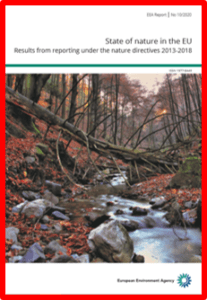
October 19, 2020
State of nature in the EU
Pub: European Environnement Agency (English text, 146 pages)
Latest evaluation shows Europe's nature in serious, continuing decline. Unsustainable farming and forestry, urban sprawl and pollution are the top pressures to blame for a drastic decline in Europe’s biodiversity, threatening the survival of thousands of animal species and habitats. Moreover, European Union nature directives and other environmental laws still lack implementation by Member States. Most protected habitats and species are not in good conservation status and much more must be done to reverse the situation. The report points to some positive developments, mostly at national or regional scale. The biodiversity strategy aims to strengthen and enlarge the network of protected areas, set up a restoration plan and ensure that ecosystems are healthy, resilient to climate change, rich in biodiversity, and deliver the range of services essential for citizens’ prosperity and well-being.
+++
Le ultime valutazioni mostrano la natura dell'Europa in grave e continuo declino. L'agricoltura e la silvicoltura non sostenibili, l'espansione urbana incontrollata e l'inquinamento sono le principali situazioni responsabili di un drastico declino della biodiversità in Europa, che minaccia la sopravvivenza di migliaia di specie animali e habitat. Inoltre, le direttive sulla natura dell'Unione Europea e altre leggi ambientali mancano ancora di attuazione da parte degli Stati membri. La maggior parte degli habitat e delle specie protette non è in buono stato di conservazione e molto di più deve essere fatto per invertire la situazione. Questo rapporto indica alcuni sviluppi positivi, principalmente su scala nazionale o regionale. La strategia per la biodiversità mira a rafforzare e ampliare la rete delle aree protette, impostare un piano di ripristino e garantire che gli ecosistemi siano sani, resistenti ai cambiamenti climatici, ricchi di biodiversità e atti a fornire la gamma di servizi essenziali per la prosperità e il benessere dei cittadini.
https://www.eea.europa.eu/publications/state-of-nature-in-the-eu-2020

8 ottobre 2020
L’Italia e gli Obiettivi di sviluppo sostenibile – Rapporto ASviS 2020
Pub: Alleanza Italiana per lo Sviluppo Sostenibile (ASviS) (testo italiano, 200 pagine)
La crisi rende più difficile il cammino verso la sostenibilità. L’Italia non ha rispettato gran parte degli impegni al 2020 dell’Agenda 2030 e la crisi incide negativamente su 9 obiettivi su 17. Peggiorano povertà, alimentazione, salute, istruzione, parità di genere, occupazione, innovazione, disuguaglianze, partnership, mentre migliorano i dati relativi all’economia circolare, la qualità dell’aria e i reati. L’ASviS indica le priorità per il Piano di ripresa e resilienza. Il Portavoce dell’ASviS Enrico Giovannini dice: “L’accordo del 2015 non è stato preso abbastanza seriamente dalla classe dirigente, dalla politica e dall’opinione pubblica e così l’Italia mancherà molti dei target fissati al 2020. La crisi in corso rischia di allontanarci dal sentiero verso l’Agenda 2030, ma la scelta dell’Unione europea a favore dello sviluppo sostenibile consente di cambiare direzione. L’ASviS avanza numerose proposte non solo su come orientare il “Piano di ripresa e resilienza” e i fondi nazionali, ma anche su come costruire una nuova governance delle politiche pubbliche, per aumentare la loro coerenza in nome del principio di giustizia intergenerazionale”
https://asvis.it/public/asvis2/files/Rapporto_ASviS/Rapporto_ASviS_2020/Report_ASviS_2020_FINAL8ott.pdf
+++
October 8, 2020
Italy and the Sustainable Development Goals - ASviS 2020 Report
Pub: Italian Alliance for Sustainable Development (ASviS) (Italian text, 200 pages)
The crisis makes the path towards sustainability more difficult. Italy has not met most of the 2020 Agenda 2030 goals and the crisis negatively affects 9 out of 17. Poverty, nutrition, health, education, gender equality, employment, innovation, inequalities, partnerships worsen, while improving data relating to the circular economy, air quality and crimes. The ASviS indicates the priorities for the Recovery and Resilience Plan. ASviS spokesman Enrico Giovannini says: “The 2015 agreement was not taken seriously enough by the ruling class, politics and public opinion and so Italy will miss many of the targets set for 2020. The current crisis risks to move away from the path towards the 2030 Agenda, but the European Union's choice in favor of sustainable development allows us to change direction. ASviS makes numerous proposals not only on how to orient the "Recovery and resilience plan" and national funds, but also on how to build a new governance of public policies, to increase their coherence in the name of the principle of intergenerational justice ".
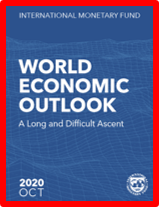
September 30, 2020
World Economic Outlook, October 2020
Pub: International Monetary Fund (English text, 202 pages)
The global economy is climbing out from the depths to which it had plummeted during the Great Lockdown in April. But with the COVID-19 pandemic continuing to spread, many countries have slowed reopening and some are reinstating partial lockdowns to protect susceptible populations. While recovery in China has been faster than expected, the global economy’s long ascent back to pre-pandemic levels of activity remains prone to setbacks. The global community should also take urgent steps to strengthen its defenses against calamitous health crises, for example by augmenting stockpiles of protective equipment and essential medical supplies, financing research, and ensuring adequate ongoing assistance to countries with limited health care capacity, including through support of international organizations.
+++
L'economia globale sta risalendo dalle profondità alle quali era precipitata durante il grande blocco di aprile. Ma con la pandemia COVID-19 che continua a diffondersi, molti Paesi hanno rallentato la riapertura e alcuni stanno ripristinando i blocchi parziali per proteggere le popolazioni sensibili. Sebbene la ripresa in Cina sia stata più rapida del previsto, la lunga ascesa dell'economia globale ai livelli di attività pre-pandemici rimane soggetta a battute d'arresto. La comunità globale dovrebbe anche adottare misure urgenti per rafforzare le proprie difese contro le calamitose crisi sanitarie, ad esempio aumentando le scorte di dispositivi di protezione e forniture mediche essenziali, finanziando la ricerca e garantendo un'adeguata assistenza continua ai Paesi con capacità sanitarie limitate, anche attraverso il sostegno di organizzazioni internazionali.
https://www.imf.org/en/Publications/WEO/Issues/2020/09/30/world-economic-outlook-october-2020

16 settembre 2020
Analisi del Rischio. I cambiamenti climatici in Italia.
Pub: Fondazione CMCC - Centro Euro-Mediterraneo sui Cambiamenti Climatici 2020 (Testo italiano, 124 pagine)
L’obiettivo di questo rapporto è quello di evidenziare quali sono gli scenari di cambiamento climatico attesi per l’Italia e quali rischi principali tali scenari potranno determinare in corrispondenza di diversi possibili livelli di riscaldamento globale, evidenziando alcune chiare priorità di intervento, anche in riferimento alla valutazione economica delle stesse e alle opportunità finanziarie. I diversi modelli climatici sono concordi nel valutare un aumento della temperatura fino a 2°C nel periodo 2021-2050 (rispetto a 1981-2010). Nello scenario peggiore l’aumento della temperatura può raggiungere i 5°C. Diminuzione delle precipitazioni estive nelle regioni del centro e del Sud, aumento di eventi precipitazioni intense. In tutti gli scenari aumenta il numero di giorni caldi e dei periodi senza pioggia. Conseguenze dei cambiamenti climatici sull’ambiente marino e costiero avranno un impatto su “beni e servizi ecosistemici” costieri che sostengono sistemi socioeconomici attraverso la fornitura di cibo e servizi di regolazione del clima.
+++
Risk Analysis. Climate change in Italy.
Pub: CMCC Foundation - Euro-Mediterranean Center on Climate Change 2020 (Italian text, 124 pages)
The objective of this report is to highlight which climate change scenarios are expected for Italy and which main risks such scenarios may determine in correspondence with different possible levels of global warming, highlighting some clear priorities for action, also in reference their economic evaluation and financial opportunities. The different climate models agree in evaluating an increase in temperature of up to 2°C in the period 2021-2050 (compared to 1981-2010). In the worst case scenario, the temperature increase can reach 5°C. Decrease in summer precipitation in the central and southern regions, increase in intense precipitation events. In all scenarios, the number of hot days and periods without rain increases. Consequences of climate change on the marine and coastal environment will have an impact on coastal "ecosystem goods and services" that support socioeconomic systems through the provision of food and climate regulation services.
https://files.cmcc.it/200916_REPORT_CMCC_RISCHIO_Clima_in_Italia.pdf
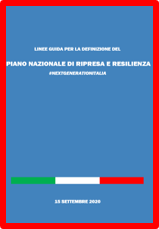
15 settembre 2020
Linee Guida per la Definizione del Piano Nazionale di Ripresa e Resilienza (#NEXTGENERATIONITALIA)
Pub: Presidenza del Consiglio dei Ministri - Repubblica Italiana (Testo italiano, 40 pagine)
Il Presidente del Consiglio dei Ministri Giuseppe Conte ha inviato ai Presidenti di Camera e Senato la proposta di linee guida per la definizione del ‘Piano nazionale di ripresa e resilienza approvate nei suoi contenuti essenziali. Il documento definisce, in via preliminare e sintetica gli obiettivi strategici di lungo termine, le aree tematiche di intervento e le azioni su cui si articolerà il Piano che l'Italia dovrà presentare alla Commissione Europea nei prossimi mesi, una volta completato l'iter di approvazione dei regolamenti attuativi del Recovery Plan europeo. Le presenti linee guida del Piano Nazionale di Ripresa e Resilienza (PNRR) rispondono all’iniziativa proposta dalla Commissione Europea e successivamente approvata dal Consiglio Europeo il 21 luglio 2020, intitolata Next Generation EU (NGEU) che, al pari del Bilancio 2021-2027 dell’Unione Europea, è attualmente al vaglio del Parlamento Europeo e dovrà poi essere ratificato dai Parlamenti nazionali. Il Piano di Rilancio del Governo è costruito intorno a tre linee strategiche: Modernizzazione del Paese; Transizione ecologica; Inclusione sociale e territoriale, parità di genere.
http://www.politicheeuropee.gov.it/media/5378/linee-guida-pnrr-2020.pdf
+++
Guidelines for the Definition of the National Recovery and Resilience Plan (#NEXTGENERATIONITALIA)
Pub: Presidency of the Council of Ministers - Italian Republic (Italian text, 40 pages)
The President of the Council of Ministers Giuseppe Conte sent to the Presidents of the Chamber and Senate the proposal of guidelines for the definition of the National Recovery and Resilience Plan approved in its essential contents. The document defines, in a preliminary and synthetic way, the long-term strategic objectives, the thematic areas of intervention and the actions on which the Plan that Italy will have to present to the European Commission in the coming months, once the process of approval of the implementing regulations of the European Recovery Plan. These guidelines of the National Recovery and Resilience Plan (PNRR) respond to the initiative proposed by the European Commission and subsequently approved by the European Council on 21 July 2020, entitled Next Generation EU (NGEU) which, like the 2021-2027 Budget of European Union, is currently being examined by the European Parliament and will then have to be ratified by national Parliaments. The Government's Relaunch Plan is built around three strategic lines: Modernization of the country; Ecological transition; Social and territorial inclusion, gender equality.

September 10, 2020
Energy Technology Perspectives 2020
Pub: International Energy Agency (English text)
This Report is a major new IEA publication focused on the technology needs and opportunities for reaching international climate and sustainable energy goals. This flagship report offers vital analysis and advice on the clean energy technologies the world needs to meet net-zero emissions objectives. The report’s comprehensive analysis maps out the technologies needed to tackle emissions in all parts of the energy sector, including areas where technology progress is still lacking such as long-distance transport and heavy industries. It shows the amount of emissions reductions that are required from electrification, hydrogen, bioenergy and carbon capture, utilisation and storage. It also provides an assessment of emissions from existing infrastructure and what can be done to address them.
+++
Questo Rapporto è una nuova importante pubblicazione IEA incentrata sulle esigenze tecnologiche e sulle opportunità per raggiungere gli obiettivi internazionali in materia di clima ed energia sostenibile. Questo rapporto di punta offre analisi e consigli fondamentali sulle tecnologie energetiche pulite di cui il mondo ha bisogno per raggiungere gli obiettivi di emissioni nette zero. L'analisi completa del rapporto delinea le tecnologie necessarie per affrontare le emissioni in tutte le parti del settore energetico, comprese le aree in cui il progresso tecnologico è ancora carente, come i trasporti a lunga distanza e le industrie pesanti. Mostra la quantità di riduzioni delle emissioni richieste da elettrificazione, idrogeno, bioenergia e cattura, utilizzo e stoccaggio del carbonio. Fornisce inoltre una valutazione delle emissioni dell'infrastruttura esistente e di cosa si può fare per affrontarle.
https://www.iea.org/reports/energy-technology-perspectives-2020

September 8, 2020
The Ecosystem of Private Investment in Climate Action
Pub: United Nations Development Programme (English text, 65 pages)
The Invest4Climate platform, a World Bank Group–United Nations Development Programme (UNDP) partnership, was designed to mobilize, coordinate, and deliver the financing needed to close the climate financing gap and help countries transition to a low carbon, resilient future that supports jobs and growth. The Invest4Climate Knowledge Series provides targeted reports on expanding private investment in climate action through financial innovation and collaborative partnerships. Private investors have a pivotal role to play in closing the multi-trillion dollar climate investment gap. Yet, the way they operate, their risk return expectations, and the way they view the threats and opportunities presented by climate change, are often not well understood by development and policy professionals. This report acts as a resource guide for any stakeholders interested in better understanding the broader ecosystem of private investment and the market facilitators that impact and enable climate-aligned investment, including how they interact with public actors.
+++
L'ecosistema degli investimenti privati nell'azione per il clima.
Pub: United Nations Development Programme (Testo in inglese, 65 pagine)
La piattaforma Invest4Climate, una partnership tra il Gruppo della Banca Mondiale e il Programma di sviluppo delle Nazioni Unite (UNDP), è stata progettata per mobilitare, coordinare e fornire i finanziamenti necessari per colmare il divario di finanziamento del clima e aiutare i Paesi a passare a un futuro a basse emissioni di carbonio e resiliente che supporti l'occupazione e crescita. La serie delle ricerche di Invest4Climate fornisce rapporti mirati sull'espansione degli investimenti privati nell'azione per il clima attraverso l'innovazione finanziaria e le partnership collaborative. Gli investitori privati hanno un ruolo fondamentale da svolgere nel colmare il divario multimiliardario di investimenti climatici. Tuttavia, il modo in cui operano, le loro aspettative di rendimento del rischio e il modo in cui vedono le minacce e le opportunità presentate dal cambiamento climatico, spesso non sono ben comprese dai professionisti dello sviluppo e delle politiche. Questo rapporto funge da guida alle risorse per tutte le parti interessate a comprendere meglio l'ecosistema più ampio degli investimenti privati e i facilitatori del mercato che hanno un impatto e consentono investimenti allineati per il clima, incluso il modo in cui interagiscono con gli attori pubblici.
https://www.undp.org/content/undp/en/home/librarypage/climate-and-disaster-resilience-/private-investment-in-climate-action.html

5 settembre 2020
Europa circolare: come gestire con successo la transizione da un mondo lineare a un mondo circolare.
Pub: Fondazione Enel - The European House – Ambrosetti
La ricerca definisce un quadro operativo per la transizione verso un modello di Economia Circolare in Europa, valuta il livello di sviluppo dei benefici dell'Economia Circolare nell'UE + UK, con un focus speciale su Italia, Romania e Spagna. Inoltre, lo studio formula raccomandazioni politiche per la transizione da un'Europa lineare a un'Europa circolare. Occorrono azioni per sfruttare appieno il potenziale dell'economia circolare. La ricerca suggerisce 10 aree di intervento con politiche specifiche: 1. definire strategie nazionali per uno sviluppo economico circolare; 2. ridefinire la governance dell'economia circolare per supportare la transizione strategica e intersettoriale; 3. fare leva sulla legislazione per promuovere la transizione; 4. livellamento del campo di gioco competitivo con soluzioni non circolari; 5. utilizzare la finanza per promuovere la ricerca e lo sviluppo sulla circolarità; 6. affrontare la mancanza di una definizione chiara e di metriche complete e omogenee; 7. trasformare i modelli di business orientati ai rifiuti in modelli circolari; 8. adottare misure trasversali e di coordinamento per tutti i settori coinvolti nella transizione all'economia circolare; 9. fare leva sull'economia circolare per ripensare le città e gli spazi urbani; 10. promuovere la cultura e la consapevolezza sui benefici legati all'economia circolare.
+++
September 5, 2020
Circular Europe: How to successfully manage the transition from a linear to a circular world.
Pub: Enel Foundation - The European House - Ambrosetti
The research defines an operational framework for the transition towards a Circular Economy model in Europe, assesses the level of development and the benefits of Circular Economy in the EU+UK, with a special focus on Italy, Romania and Spain. Moreover, the study formulates policy recommendations for the transition from a linear to a circular Europe. Actions are needed to full exploit the game-changing potential of Circular Economy. The research suggests 10 areas of intervention with specific policies: 1. defining national strategies for a circular economic development; 2. redefining the governance of circular economy in order to support strategic and cross sectorial transition; 3. leveraging on legislation to promote the transition; 4. levelling the competitive playing field with non-circular solutions; 5. using finance to promote research and development on circularity; 6. addressing the lack of a clear definition and of comprehensive and homogenous metrics; 7. turning waste-oriented business models into circular ones; 8. adopting cross-cutting and coordination measures for all the sectors involved in the Circular Economy transition; 9. leveraging on circular economy to rethink cities and urban spaces; 10. promoting the culture and awareness on the benefits related to Circular Economy.
https://www.enelfoundation.org/topic/a/2020/09/circular-europe

August 11, 2020
Catalyzing Private Sector Investment in Climate Smart Cities
Pub: United Nations Development Programme (English text, 70 pages)
The objective of this report is to explore innovative financing instruments and approaches for catalyzing private sector financing to fill the climate-smart investment gap in cities. The report reviews the existing literature, highlights key barriers in scaling-up private investment in climate-smart urban infrastructure, and showcases innovative financial de-risking instruments and other financial instruments for private sector financing for low carbon, resilient urban investments. The first chapter of the report introduces the topic and the second presents the challenges and the opportunities of urban climate investments. The third chapter discusses climate-smart cities and types of urban mitigation and resilience investments. The fourth chapter reviews and provides a framework to examine the interconnected layers of investment barriers specific to private investment, city financing, and climate-smart projects. Considering these risks allows investors and other stakeholders to better understand the complex web of challenges to expanding investment in urban climate projects and how they build on one another. Chapter five presents 10 case studies of innovative financing approaches to address some of these barriers and mobilize private sector finance for low carbon, resilient urban development.
+++
Catalizzare gli investimenti del settore privato nelle città intelligenti per il clima.
Pub: United Nations Development Program (Testo in inglese, 70 pagine)
L'obiettivo di questo rapporto è esplorare strumenti di finanziamento innovativi e approcci per catalizzare i finanziamenti del settore privato per colmare il divario di investimenti intelligenti per il clima nelle città. Il rapporto esamina la letteratura esistente, evidenzia le principali barriere all'aumento degli investimenti privati in infrastrutture urbane intelligenti per il clima e mette in mostra strumenti finanziari innovativi di riduzione del rischio e altri strumenti finanziari per il finanziamento del settore privato rivolti a investimenti urbani resilienti a basse emissioni di carbonio. Il primo capitolo del rapporto introduce l'argomento e il secondo presenta le sfide e le opportunità degli investimenti sul clima urbano. Il terzo capitolo discute delle città intelligenti per il clima e dei tipi di investimenti per la mitigazione e la resilienza urbana. Il quarto capitolo esamina e fornisce un quadro per esaminare gli strati interconnessi di barriere agli investimenti specifici per investimenti privati, finanziamenti urbani e progetti climatici. La considerazione di questi rischi consente agli investitori e ad altre parti interessate di comprendere meglio la complessa rete di sfide per espandere gli investimenti in progetti sul clima urbano e come si basano l'uno sull'altro. Il capitolo cinque presenta 10 studi di casi di approcci di finanziamento innovativi per affrontare alcuni di questi ostacoli e mobilitare i finanziamenti del settore privato per uno sviluppo urbano resiliente a basse emissioni di carbonio.
https://www.undp.org/content/undp/en/home/librarypage/poverty-reduction/private_sector/catalyzing-private-sector-investment-in-climate-smart-cities.html
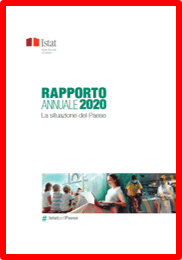
3 luglio 2020
Rapporto annuale 2020. La situazione del Paese. (Italia)
Pub: ISTAT (Testo italiano, 289 pagine)
A metà 2020 il quadro economico e sociale italiano si presenta eccezionalmente complesso e incerto. Al rallentamento congiunturale del 2019 si è sovrapposto l’impatto della crisi sanitaria e, nel primo trimestre, il Pil ha segnato un crollo congiunturale del 5,3%; i segnali più recenti includono: inflazione negativa, calo degli occupati, marcata diminuzione della forza lavoro e caduta del tasso di attività, una prima risalita dei climi di fiducia. Le previsioni Istat stimano per il 2020 un forte calo dell’attività economica, solo in parte recuperato l’anno successivo. Nel 2019 è proseguito il riequilibrio dei saldi di finanza pubblica, ma le azioni di bilancio volte a contrastare la crisi avranno un impatto rilevantissimo sulla finanza pubblica. Una rilevazione ad hoc dell’Istat presso le imprese mostra che i fattori di fragilità sono molto diffusi ed è cruciale la questione del reperimento della liquidità, seppure emergano elementi di reazione positiva.
+++
In mid 2020, the Italian economic and social situation is exceptionally complex and uncertain. The impact of the health crisis was superimposed on the economic downturn in 2019 and, in the first quarter, GDP marked a cyclical collapse of 5.3%; the most recent signs include: negative inflation, a decline in the number of employed workers, a marked decrease in the workforce and a fall in the activity rate, a first rise in confidence. Istat forecasts estimate for 2020 a sharp drop in economic activity, only partially recovered the following year. In 2019, the rebalancing of public finance balances continued, but budget actions aimed at tackling the crisis will have a very significant impact on public finance. An ad hoc survey of Istat among companies shows that the factors of fragility are widespread and the question of finding liquidity is crucial, even if elements of positive reaction emerge.
https://www.istat.it/storage/rapporto-annuale/2020/Rapportoannuale2020.pdf

June 2020
World Youth Report
Pub: United Nations (English text, 148 pages)
Youth Social Entrepreneurship and the 2030 Agenda seeks to contribute to the understanding of how youth social entrepreneurship can both support youth development and help accelerate the implementation of the SDGs. The Report assesses the potential and the challenges of youth social entrepreneurship as a tool supporting the 2030 Agenda and youth development in its broadest sense. The Report examines how new technologies can be leveraged to address some challenges faced by young social entrepreneurs as well as further support youth social entrepreneurship in its efforts to advance sustainable development. This last chapter finally offers policy guidance to build enabling, responsive and sustainable national ecosystems for young social entrepreneurs. Throughout the report, info boxes and case studies illustrate the impact youth social entrepreneurship can have when entrepreneurial ecosystems are aligned with the needs, characteristics, constraints and ambitions of young people.
+++
L'imprenditoria sociale giovanile e l'Agenda 2030 mirano a contribuire alla comprensione di come si possa sia sostenere lo sviluppo della gioventù sia contribuire ad accelerare l'attuazione degli obiettivi di sviluppo sostenibile. La relazione sintetizza innanzitutto l'attuale discussione sull'imprenditoria sociale e la fissa nel contesto dell'agenda 2030. Il Rapporto valuta il potenziale e le sfide esaminando innanzitutto come le nuove tecnologie possono essere sfruttate per affrontare alcune sfide affrontate dai giovani imprenditori sociali L'ultimo capitolo offre infine una guida politica per costruire ecosistemi nazionali abilitanti, reattivi e sostenibili per i giovani imprenditori sociali. Nel corso del rapporto, caselle informative e case study illustrano l'impatto che l'imprenditoria sociale giovanile può avere quando gli ecosistemi imprenditoriali sono allineati con le esigenze, le caratteristiche, i vincoli e le ambizioni dei giovani.
https://www.un.org/development/desa/youth/world-youth-report/wyr2020.html

June 13, 2020
Infrastructure in a changing world: trends and challenges.
Pub: ISPI (English text, 207 pages)
Aut: Carlo Secchi, Alberto Belladonna
In a world on the brink of a global recession caused by COVID-19, the Infrastructure efforts of today and tomorrow are more crucial than ever. They are an indispensable countercyclical tool to mitigate the negative effects of the economic paralysis. But they also constitute a pivotal component of a country’s development and competitiveness in the long term. That is why infrastructure will continue to play a critical role even when the pandemic crisis has been tamed. Rapid demographic growth, increasing urbanization, especially in developing countries, coupled with the mounting climate change are challenges that won’t disappear with the virus. These significant challenges will come with equally difficult questions. How to cope with these long-term trends? How to finance the increasing need of infrastructure? Which major international actors will take the lead? And finally, what role will technology play in shaping the future of infrastructure efforts?
+++
In un mondo sull'orlo di una recessione globale causata da COVID-19, gli sforzi infrastrutturali di oggi e di domani sono più cruciali che mai. Sono uno strumento anticiclico indispensabile per mitigare gli effetti negativi della paralisi economica. Ma costituiscono anche una componente fondamentale dello sviluppo e della competitività di un paese a lungo termine. Ecco perché le infrastrutture continueranno a svolgere un ruolo critico anche quando la crisi pandemica sarà stata domata. La rapida crescita demografica, la crescente urbanizzazione, specialmente nei Paesi in via di sviluppo, insieme al crescente cambiamento climatico sono sfide che non scompariranno con il virus. Queste sfide significative arriveranno con domande altrettanto difficili. Come far fronte a queste tendenze a lungo termine? Come finanziare il crescente bisogno di infrastrutture? Quali principali attori internazionali assumeranno la guida? E infine, quale ruolo giocherà la tecnologia nel plasmare il futuro degli sforzi infrastrutturali?
https://www.ispionline.it/sites/default/files/pubblicazioni/ispi_report-infrastructure_2020.pdf
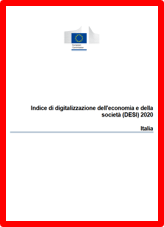
11 giugno 2020
Indice di digitalizzazione dell'economia e della società (DESI) 2020 - Italia
Pub: Commissione Europea (Testo italiano, 15 pagine)
L'Italia si colloca al 25º posto fra i 28 Stati membri dell'UE. I dati precedenti la pandemia indicano che il Paese è in una buona posizione in termini di preparazione al 5G, in quanto sono state assegnate tutte le bande pioniere e sono stati lanciati i primi servizi commerciali. Sussistono carenze significative per quanto riguarda il capitale umano. Rispetto alla media UE, l'Italia registra livelli di competenze digitali di base e avanzate molto bassi. Anche il numero di specialisti e laureati nel settore telecomunicazioni è molto al di sotto della media UE. Queste carenze in termini di competenze digitali si riflettono nel modesto utilizzo dei servizi online, compresi i servizi pubblici digitali.
+++
Italy ranks 25th among the 28 EU Member States. Pre-pandemic data indicate that the country is in a good position in terms of 5G preparation, as all pioneer broadbands have been assigned and the first commercial services have been launched. There are significant shortcomings with regard to human capital. Compared to the EU average, Italy has very low basic and advanced digital skills levels. The number of telecommunications specialists and graduates is also well below the EU average. These shortcomings in digital skills are reflected in the modest use of online services, including digital public services.
https://d110erj175o600.cloudfront.net/wp-content/uploads/2020/06/report-italia.pdf

June 4, 2020
Covid-19, changing social practices and the transition to sustainable production and consumption.
Pub: Sustainable Consumption Institute (English text, 33 pages)
Existing research indicates that disruption and change of practices is already widespread in key areas such as hygiene, foodprovision, mobility, shopping, alternative economies andthrift, water use and gardening, andhousehold work, coordinationand care. Four imagined futuresare presented as possible outcomes involving various levels of retaining newpractices: (1) Recovery, (2) Collapse, (3) Accelerated Transition to Digitalisationand (4) Accelerated Transition to Sustainable Development. The likelihood of one of these four imagined futures materialising is dependent on individual and collective choiceand the way it anticipates and responds to local and global socio-ecological conditions.
+++
Le ricerche esistenti indicano che l'interruzione e il cambiamento delle pratiche sociali sono già molto diffusi in settori chiave quali igiene, approvvigionamento alimentare, mobilità, shopping, economie alternative e risparmio, uso dell'acqua e giardinaggio, lavoro domestico, coordinamento e assistenza. Quattro futuri immaginati sono presentati come possibili esiti che coinvolgono vari livelli di mantenimento di nuove pratiche: (1) Recupero, (2) Crollo, (3) Transizione accelerata alla digitalizzazione e (4) Transizione accelerata allo sviluppo sostenibile. La probabilità che uno di questi quattro futuri immaginati si materializzi dipende dalla scelta individuale e collettiva e dal modo in cui anticipa e risponde alle condizioni socio-ecologiche locali e globali.
http://documents.manchester.ac.uk/display.aspx?DocID=49196

29 maggio 2020
Relazione annuale 2019
Pub: Banca d’Italia (Testo italiano, 219 pagine)
La Relazione affronta sia lo scenario dell’economia internazionale che quello italiano, le condizioni di famiglie e imprese, il mercato del lavoro, l’interscambio con l’estero, la finanza pubblica e le conseguenze della crisi sanitaria del 2020. Nel 2019 l’attività economica ha rallentato, risentendo degli andamenti sfavorevoli dell'economia globale e delle tensioni protezionistiche che hanno interessato soprattutto la manifattura. All'inizio del 2020 il sistema produttivo è stato colpito dalla diffusione dell'epidemia di Covid-19; ne è conseguita già nel primo trimestre una forte contrazione del prodotto. Il calo è stato più marcato per i servizi turistici, della ristorazione, di trasporto, ricreativi e culturali, ma la flessione è stata diffusa. È diminuita anche la natalità di impresa: nel primo trimestre il saldo tra le iscrizioni e le cessazioni di aziende è stato ampiamente negativo, collocandosi al livello più basso degli ultimi sette anni.
+++
The Report addresses both the international and Italian economic scenario, the conditions of families and businesses, the labor market, foreign exchange, public finance and the consequences of the 2020 health crisis. In 2019 the economic activity slowed down, reflecting the unfavorable trends of the global economy and the protectionist tensions that affected manufacturing above all. At the beginning of 2020, the production system was hit by the spread of the Covid-19 epidemic; this led to a sharp contraction in the product already in the first quarter. The decline was more marked for tourism, catering, transport, recreational and cultural services, but the decline was widespread. The birth rate of companies also decreased: in the first quarter the balance between registrations and terminations of companies was largely negative, standing at the lowest level in the last seven years.
https://www.bancaditalia.it/pubblicazioni/relazione-annuale/2019/rel_2019.pdf
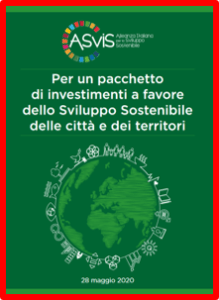
28 maggio 2020
Per un pacchetto di investimenti a favore dello Sviluppo Sostenibiledelle città e dei territori
Pub: Alleanza Italiana per lo sviluppo sostenibile (ASviS) (Testo italiano, 28 pagine)
Le imprese e il governo puntino alla sostenibilità per rilanciare la competitività. Enrico Giovannini, portavoce ASviS, dice: “La risposta alla crisi deve essere orientata a portare l’Italia su un sentiero di sviluppo sostenibile da tutti i punti di vista. L’ottima proposta della Commissione europea apre per l’Italia una concreta possibilità di trasformarsi nella direzione dell’Agenda 2030. Ma anche il bilancio pubblico nazionale va orientato alla sostenibilità: per questo proponiamo di eliminare i 19 miliardi annui di sussidi dannosi per l’ambiente per ridurre il cuneo fiscale, sostenere le imprese nel passaggio alle energie rinnovabili e all’economia circolare, investire su giovani e donne. La sostenibilità accresce la produttività delle aziende e migliora la qualità della vita delle persone. Ecco perché il rilancio del Paese deve passare per un ripensamento dei modelli di business e delle politiche a favore dello sviluppo sostenibile”.
+++
Investments in favor of the sustainable development of cities and territories
Companies and the government aim for sustainability to boost competitiveness. Enrico Giovannini, ASviS spokesman, says: "The response to the crisis must be oriented towards taking Italy on a path of sustainable development from all points of view. The excellent proposal of the European Commission opens up a real possibility for Italy to transform itself in the direction of the 2030 Agenda. But also the national public budget must be oriented towards sustainability: for this reason we propose to eliminate the 19 billion per year of subsidies harmful to the environment to reduce the tax wedge, support companies in the transition to renewable energy and the circular economy, invest in young people and women. Sustainability increases the productivity of companies and improves the quality of life of people. That's why the relaunch of the country must go through a rethinking of business models and policies in favor of sustainable development".
https://asvis.it/public/asvis2/files/Pubblicazioni/Investimenti_SviluppoSostenibile_citta_territori.pdf

14 maggio 2020
Rapporto SDGs 2020. Informazioni Statistiche per l’Agenda 2030 In Italia.
Pub: Istat (Testo italiano, 271 pagine)
Rapporto sui Sustainable Development Goals (SDGs) adottati con l’Agenda 2030 dall’Assemblea Generale delle Nazioni Unite. I 17 obiettivi di sviluppo sostenibile (SDGs) e i relativi 169 target bilanciano le tre dimensioni dello sviluppo sostenibile, estendendo l’Agenda 2030 dal solo pilastro sociale a quello economico ed all’ambientale. Nel Rapporto SDGs 2020, le misure statistiche prodotte sono 325, per 130 indicatori UN-IAEG. Di queste misure, 125 sono state aggiornate rispetto alla diffusione effettuata sul sito dell’Istituto a dicembre 2019. Un’attenzione particolare è stata dedicata alle disaggregazioni regionali, a quelle per livello di urbanizzazione, oltre che a quelle per genere, cittadinanza e disabilità. Poichè la diffusione del Rapporto SDGs 2020 avviene durante la pandemia di Covid-19, sebbene il Rapporto contenga prevalentemente informazioni aggiornate al 2019, si è cercato di dare conto dell’impatto dell’emergenza sanitaria in attraverso uno schema delle interconnessioni e reti che presenta le interazioni tra il Covid-19 e i diversi goal e tramite un esercizio di valutazione controfattuale che, a partire dal lockdown, stima la riduzione delle emissioni generate dai comportamenti assunti da famiglie e imprese.
+++
Report on Sustainable Development Goals (SDGs) adopted with the 2030 Agenda by the United Nations General Assembly. The 17 sustainable development goals (SDGs) and the related 169 targets balance the three dimensions of sustainable development, extending the 2030 Agenda from the social pillar to the economic and environmental pillar. In the SDGs 2020 Report, the statistical measures produced are 325, for 130 UN-IAEG indicators. Of these measures, 125 have been updated with respect to the dissemination carried out on the Institute's website in December 2019. Particular attention has been paid to regional breakdowns, to those by urbanization level, as well as those by gender, citizenship and disability. Since the distribution of the SDGs 2020 Report occurs during the Covid-19 pandemic, although the Report mainly contains information updated to 2019, an attempt has been made to account for the impact of the health emergency in a scheme of interconnections and networks that presents the interactions between Covid-19 and the various goals and through a counterfactual evaluation exercise which, starting from the lockdown, estimates the reduction of emissions generated by the behavior of families and businesses.
https://www.istat.it/it/files//2020/05/SDGs_2020.pdf

April 2020
Understanding Value in Media Perspectives from Consumers and Industry
Pub: Weforum (English text, 40 pages)
The paper has three objectives: first, to analyse research conducted in six key markets – Germany, South Korea, the UK, and the US, China and India; second, to highlight the implications for media business models; third, to raise awareness to our Shaping the Future of Media, Entertainment and Culture platform.The results are based on a survey, conducted by Nielsen for the Forum, of more than 9,100 consumers. To complement the data, our project team organized six workshops, convening around 100 executives from across the media industry.
+++
Il documento ha tre obiettivi: in primo luogo, analizzare le ricerche condotte in sei mercati chiave: Germania, Corea del Sud, Regno Unito e Stati Uniti, Cina e India; secondo, evidenziare le implicazioni per i modelli di business dei media; terzo, aumentare la consapevolezza per la nostra piattaforma Shaping the Future of Media, Entertainment and Culture. I risultati si basano su un sondaggio, condotto da Nielsen per il Forum, di oltre 9.100 consumatori. Per integrare i dati, il nostro team di progetto ha organizzato sei seminari, riunendo circa 100 dirigenti provenienti da tutto il settore dei media.
http://www3.weforum.org/docs/WEF_Understanding_Value_in_Media_Perspectives_from_Consumers_and_Industry_2020.pdf

April 27, 2020
Green Deal for All
Pub: Institute for European Environmental Policy (English text, 30 pages)
This policy report analyses how to achieve sustainability and equity between the people, regions, countries and generations of Europe in a post-COVID-19 era. This paper argues that the Green Deal becomes an even more essential policy in the new context of recovery from the recession and provides an unintended opportunity not to return to the past and instead “build back better”. Conversely, the paper warns against an unsustainable recovery pathway which would waste precious public funds on shoring up the fossil fuel economy and lock Europe’s youth and future generations into destructive high-carbon and unsustainable pathways. The European Green Deal is a necessary part of the EU recovery plan and therefore should be reflected in the Multiannual Financial Framework (MFF). Whilst it is paramount to address the current emergency needs, planning for the future and the transformation of our economies also needs to be taking place.
+++
Questo rapporto politico analizza come raggiungere la sostenibilità e l'equità tra le persone, le regioni, i paesi e le generazioni d'Europa in un'era post-COVID-19. Questo documento sostiene che il Green Deal diventa una politica ancora più essenziale nel nuovo contesto di ripresa dalla recessione e offre un'opportunità non intenzionale di non tornare al passato e invece " ricostruire meglio ”. Al contrario, il documento mette in guardia contro un percorso di recupero insostenibile che sprecherebbe preziosi fondi pubblici per sostenere l'economia dei combustibili fossili e bloccare i giovani e le generazioni future dell'Europa in percorsi distruttivi ad alto tenore di carbonio e insostenibili. Il Green Deal europeo è una parte necessaria del piano di risanamento dell'UE e dovrebbe pertanto riflettersi nel Quadro Finanziario Pluriennale (QFP). Sebbene sia di fondamentale importanza affrontare le attuali esigenze di emergenza, occorre anche pianificare il futuro e la trasformazione delle nostre economie.
https://ieep.eu/uploads/articles/attachments/62021d1c-86b4-4a86-a293-4f2bc34d3043/Green%20Deal%20for%20All%20-%20FINAL%20PP.pdf?v=63755214067

24 aprile 2020
Documento di economia e finanza DEF 2020
Pub: Governo italiano (Testo italiano, 146+132+5 pagine)
E’ il Documento di Economia e Finanza 2020 (DEF), approvato dal Consiglio dei Ministri della Repubblica Italiana. L’eccezionalità della crisi pandemica da Coronavirus (COVID-19) e gli straordinari impegni di finanza pubblica - derivanti dalle misure di contenimento e cura e dalle misure per far fronte alla forte contrazione dell’economia – hanno fatto sì che il DEF 2020 sia più essenziale rispetto ai precedenti. Gli scenari di previsione della finanza pubblica, in linea con gli altri paesi dell’Unione Europea, sono limitati al periodo 2020-2021 e viene posticipata la presentazione del Programma Nazionale di Riforma. Prima fra le nazioni europee ad essere stata investita dalla crisi, l’Italia ha aperto la strada sia alla definizione di politiche di contrasto e di distanziamento sociale, che alla messa in campo di misure economiche di sostegno, sempre più necessarie per far fronte alle chiusure delle attività economiche non considerate essenziali.La marcata revisione dello scenario macroeconomico in confronto a quello che si andava delineando porta la previsione del PIL per l’anno in corso ad una contrazione pari a 8,0 punti percentuali, con un indebitamento netto delle Amministrazioni pubbliche al 10,4% del PIL. Per il 2021, il DEF prevede un rimbalzo consistente dell’economia italiana con il PIL in crescita del 4,7%.
+++
It is the Document of Economy and Finance 2020 (DEF), approved by the Council of Ministers of the Italian Republic. The exceptional nature of the Coronavirus pandemic crisis (COVID-19) and the extraordinary public finance commitments - resulting from containment and care measures and measures to cope with the strong contraction of the economy - have made DEF 2020 more essential compared to the previous ones. The public finance forecasting scenarios, in line with the other countries of the European Union, are limited to the 2020-2021 period and the presentation of the National Reform Program is postponed. First among the European nations to have been hit by the crisis, Italy has paved the way both for the definition of policies of contrast and social distancing, and for the implementation of economic support measures, increasingly necessary to face the closures of economic activities not considered essential. The marked revision of the macroeconomic scenario compared to what was emerging leads the forecast of GDP for the current year to a contraction of 8.0 percentage points, with a net debt of general government at 10.4% of GDP . For 2021, the DEF expects a significant rebound in the Italian economy with GDP growing by 4.7%.
http://www.mef.gov.it/inevidenza/Approvato-il-DEF-2020-ripartire-dopo-lemergenza/

24 aprile 2020
Garantire la salute e la sicurezza sul lavoro durate una pandemia.
Pub: Organizzazione Mondiale del Lavoro, ILO (Testo italiano, 52 pagine)
In alcune parti del mondo cresce la preoccupazione per il continuo aumento delle infezioni daCOVID-19, mentre in altri si cerca di di mantenere basso il numero di contagi. I governi, i datori di lavoro, i lavoratori e le loro organizzazioni affrontano sfide enormi nel tentativo di combattere la pandemia da COVID-19 e proteggere la salute e la sicurezza sul lavoro. Oltre alla crisi immediata, vi è anche la preoccupazione per la ripresa dell’attività affinché non si vanifichino i risultati ottenuti intermini di appiattimento della curva dei contagi. Il presente rapporto evidenzia i rischi per la salute e la sicurezza sul lavoro (SSL) derivanti dalla diffusione del COVID-19. Esso analizza altresì le misure per prevenire e mitigare i rischi di contagio, nonché quelli psicosociali, ergonomici e gli altri rischi per la salute e la sicurezza sul lavoro associati alla pandemia.
+++
In some parts of the world there is growing concern about the continuous increase in COVID-19 infections, while in others efforts are being made to keep the number of infections low. Governments, employers, workers and their organizations face huge challenges in an attempt to combat the COVID-19 pandemic and protect occupational health and safety. In addition to the immediate crisis, there is also concern about the resumption of activity so that the intermediate results obtained by flattening the contagion curve will not be nullified. This report highlights the risks to health and safety at work (SSL) deriving from the diffusion of COVID-19. It also analyzes measures to prevent and mitigate contagion risks, as well as psychosocial, ergonomic and other occupational health and safety risks associated with the pandemic.
https://www.ilo.org/wcmsp5/groups/public/---europe/---ro-geneva/---ilo-rome/documents/publication/wcms_742884.pdf
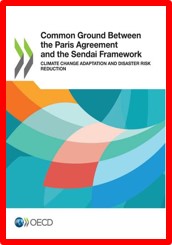
April 20, 2020
Common Ground Between the Paris Agreement and the Sendai Framework. Climate Change Adaptation and Disaster Risk Reduction.
Pub: OECD (English text, 170 pages)
The adoption in 2015 of the Sendai Framework for Disaster Risk Reduction and the Paris Agreement on climate change provides a clear mandate for increased coherence in countries’ approaches to climate and disaster risk reduction. Countries increasingly recognise the benefits of improved coherence between the two areas, exemplified by the number of countries that either have developed joint strategies or put in place processes that facilitate co-ordination. Informed by the country approaches of Ghana, Peru and the Philippines, in addition to a review of relevant literature, this report examines the potential for increased coherence in approaches to climate change adaptation and disaster risk reduction across levels of government and sectors. It identifies ways in which government officials, development co-operation and other stakeholders can support efforts to further enhance coherence between the two areas, not only in the three case study countries, but also those in other countries as well as providers of development co-operation.
+++
Terreno comune tra l'accordo di Parigi e il quadro di Sendai. Adattamento ai cambiamenti climatici e riduzione del rischio di catastrofi.
L'adozione nel 2015 del quadro di Sendai per la riduzione del rischio di catastrofi e dell'accordo di Parigi sui cambiamenti climatici fornisce un chiaro mandato per una maggiore coerenza negli approcci dei Paesi alla riduzione del rischio climatico e catastrofico. I Paesi riconoscono sempre più i vantaggi di una migliore coerenza tra i due settori, esemplificato dal numero di Paesi che hanno sviluppato strategie comuni o messo in atto processi che facilitano il coordinamento. Informato dagli approcci nazionali di Ghana, Perù e Filippine, oltre a una revisione della letteratura pertinente, questo rapporto esamina il potenziale per una maggiore coerenza negli approcci all'adattamento ai cambiamenti climatici e alla riduzione del rischio di catastrofi tra livelli di governo e settori. Identifica i modi in cui i funzionari governativi, la cooperazione allo sviluppo e altre parti interessate possono sostenere gli sforzi per rafforzare ulteriormente la coerenza tra i due settori, non solo nei tre Paesi di studio del caso, ma anche quelli di altri Paesi e fornitori di servizi di cooperazione per lo sviluppo.
https://read.oecd-ilibrary.org/development/climate-change-adaptation-and-disaster-risk-reduction_3edc8d09-en#page1

April 9, 2020
Financing for Sustainable Development Report 2020
Pub: United Nations (English text, 207 pages)
The economic and financial shocks associated with Covid-19—such as disruptions to industrial production, falling commodity prices, financial market volatility, and rising insecurity—are derailing the already tepid economic growth and compounding heightened risks from other factors. These include the retreat from multilateralism, a discontent and distrust of globalization, heightened risk of debt distress, and more frequent and severe climate shocks. Together, these make sustainable finance more difficult—and further undermine the ability to achieve the Sustainable Development Goals (SDGs) by 2030. The international community needs to take immediate concerted actions to respond to Covid-19. Governments should coordinate measures at the global level to ensure maximum impact and signal global resolve to main-tain economic and financial stability, promote trade and stimulate growth.
+++
Gli shock economici e finanziari associati al Covid-19, come interruzioni della produzione industriale, calo dei prezzi delle materie prime, volatilità dei mercati finanziari e crescente insicurezza, stanno facendo deragliare la già tiepida crescita economica e aggravando i rischi di altri fattori. Questi includono il ritiro dal multilateralismo, uno scontento e una sfiducia nei confronti della globalizzazione, un aumento del rischio di sofferenza del debito e shock climatici più frequenti e gravi. Insieme, questi rendono più difficile la finanza sostenibile e minano ulteriormente la capacità di raggiungere gli Obiettivi di sviluppo sostenibile (SDGs) entro il 2030. La comunità internazionale deve intraprendere azioni concertate immediate per rispondere al Covid-19. I governi dovrebbero coordinare le misure a livello globale per garantire il massimo impatto e segnalare la volontà globale di mantenere la stabilità economica e finanziaria, promuovere gli scambi e stimolare la crescita.
https://developmentfinance.un.org/sites/developmentfinance.un.org/files/FSDR_2020.pdf

March 2020
Shared Responsibility, Global Solidarity: responding to the socio-economic impacts of Covid-19
Pub: United Nations (English text, 26 pages)
This report is a call to action, for the immediate health response required to suppress transmission of the virus to end the pandemic; and to tackle the many social and economic dimensions of this crisis. It is, above all, a call to focus on people – women, youth, low-wage workers, small and medium enterprises, the informal sector and on vulnerable groups who are already at risk.
+++
Questo rapporto è un invito all'azione, per l'immediata risposta sanitaria necessaria per sopprimere la trasmissione del virus e porre fine alla pandemia; per affrontare le molte dimensioni sociali ed economiche di questa crisi. È soprattutto un invito a concentrarsi sulle persone: donne, giovani, lavoratori a basso salario, piccole e medie imprese, settore informale e gruppi vulnerabili che sono già a rischio.
https://www.un.org/sites/un2.un.org/files/sg_report_socio-economic_impact_of_covid19.pdf
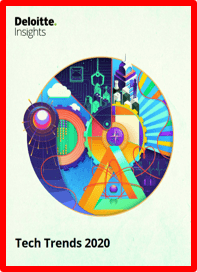
March 2020
Tech Trends 2020
Pub: Deloitte (132 pages, English text)
In 2020, THE next stage of digital’s evolution welcomes us with the promise of emotionally intelligent interfaces and hyperintuitive cognitive capabilities that will transform business in unpredictable ways. Yet as we prepare for the coming decade of disruptive change, we would be wise to remember an important point about yesteryear’s leading-edge innovations: Architects of the 1980s designed mainframe systems that continue to run and generate business value today. Architecting for longevity and adaptability requires a deep understanding of both today’s realities and tomorrow’s possibilities. It requires an appreciation for the technology and market forces driving change. And finally, it requires a long-term commitment to focused and incremental progress.
+++
Nel 2020 il prossimo stadio dell'evoluzione digitale ci accoglie con la promessa di interfacce emotivamente intelligenti e capacità cognitive iperintuitive che trasformeranno il business in modi imprevedibili. Eppure, mentre ci prepariamo per il prossimo decennio di cambiamenti dirompenti, sarebbe saggio ricordare un punto importante sulle innovazioni all'avanguardia di un tempo: gli architetti degli anni '80 hanno progettato sistemi mainframe che continuano a funzionare e generare valore commerciale oggi. L'architettura per la longevità e l'adattabilità richiede una profonda comprensione delle realtà di oggi e delle possibilità di domani. Richiede un apprezzamento per la tecnologia e le forze di mercato che guidano il cambiamento. E infine, richiede un impegno a lungo termine per progressi mirati e incrementali.
https://www2.deloitte.com/content/dam/insights/us/articles/tech-trends-2020/DI_TechTrends2020.pdf

March 21, 2020
The United Nations World Water Development Report 2020 ‘Water and Climate change’
Pub: United Nations Water (English text, 235 pages)
Climate change challenges the sustainability of water resources, which are already under severe pressure in many regions of the world, and amplifies water-related extremes including floods and droughts.Water availability will become more unreliable with increased climate variability, aggravating the situation in water-stressed regions and generating similar problems in areas that have not yet been as severely affected. Water related disasters will become more frequent and severe. Food security, human health, urban and rural settlements, energy production, industrial development, economic growth, and thriving ecosystems are all water-dependent and thus vulnerable to the impacts of climate change.
+++
I cambiamenti climatici mettono in discussione la sostenibilità delle risorse idriche, che sono già sottoposte a forti pressioni in molte regioni del mondo e amplificano i problemi legati all'acqua, tra cui inondazioni e siccità. La disponibilità di acqua diventerà più inaffidabile con una maggiore variabilità climatica, aggravando la situazione in regioni stressate e generando problemi simili in aree che non sono state ancora gravemente colpite. Le catastrofi legate all'acqua diventeranno più frequenti e gravi. La sicurezza alimentare, la salute umana, gli insediamenti urbani e rurali, la produzione di energia, lo sviluppo industriale, la crescita economica e gli ecosistemi attivi sono tutti dipendenti dall'acqua e quindi vulnerabili agli impatti dei cambiamenti climatici.
https://unesdoc.unesco.org/ark:/48223/pf0000372985.locale=en

March 18, 2020
Banking On Climate Change Fossil Fuel Finance Report 2020
Pub: Rainforest action network (English text, 11 pages)
This report adds up financing from 35 private-sector banks to the fossil fuel industry, summing their leading roles in lending and underwriting of debt and equity issuances. These 35 banks from Canada, China, Europe, Japan, and the U.S. have together funneled USD $2.7 trillion into fossil fuels in the four years since the Paris Agreement was adopted (2016-2019). The financial companies are increasingly being recognized — by their clients, shareholders, regulators, and the general public — as climate actors, with a responsibility to mitigate their climate impact. For the banks highlighted in this report, the last year has brought a groundswell of activism demanding banks cut their fossil fuel financing, at the same time that increasingly extreme weather events have further underscored the urgency of the climate crisis.
+++
Questo rapporto segnala i finanziamenti da 35 banche del settore privato all'industria dei combustibili fossili, riassumendo i loro ruoli principali nel prestito e nella sottoscrizione di emissioni di titoli di debito e azionari. Queste 35 banche di Canada, Cina, Europa, Giappone e Stati Uniti hanno raccolto insieme 2,7 trilioni di dollari nei quattro anni successivi all'adozione dell'accordo di Parigi (2016-2019). Le società finanziarie vengono sempre più riconosciute dai loro clienti, azionisti, autorità di regolamentazione e dal pubblico in generale, come attori del clima, con la responsabilità di mitigare il loro impatto sul clima stesso. Alle banche evidenziate in questo rapporto, lo scorso anno ha portato un'ondata di attivismo con la richiesta di tagliare il finanziamento dei combustibili fossili, mentre eventi meteorologici sempre più estremi hanno ulteriormente sottolineato l'urgenza della crisi climatica.
https://www.ran.org/wp-content/uploads/2020/03/Banking_on_Climate_Change__2020_vF.pdf
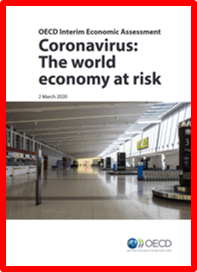
March 2, 2020
Coronavirus: The world economy at risk
Pub: OECD (18 pages, English text)
Global economic prospects remain subdued and very uncertain due to the coronavirus outbreak. The coronavirus (COVID-19) outbreak has already brought considerable human suffering and major economic disruption. In China, containment efforts have involved quarantines and widespread restrictions on labour mobility and travel, resulting in unplanned delays in restarting factories after the Lunar New Year holiday and sharp cutbacks in many service sector activities. These measures imply a sizeable output contraction whilst the effects of the outbreak persist. Subsequent outbreaks in other countries, including Korea and Italy, have also prompted containment measures such as quarantines and border closures, albeit on a smaller scale.
+++
Le prospettive economiche globali rimangono modeste e molto incerte a causa dell'epidemia di coronavirus. L'epidemia di coronavirus (COVID-19) ha già causato notevoli sofferenze umane e gravi perturbazioni economiche. In Cina, gli sforzi di contenimento hanno comportato quarantene e restrizioni diffuse sulla mobilità dei lavoratori e sui viaggi, con conseguenti ritardi non pianificati nel riavvio delle fabbriche dopo le vacanze di Capodanno lunare e tagli drastici in molte attività del settore dei servizi. Queste misure implicano una notevole contrazione della produzione mentre persistono gli effetti dell'epidemia. I successivi focolai in altri paesi, tra cui la Corea e l'Italia, hanno anche indotto misure di contenimento come quarantene e chiusure delle frontiere, sebbene su scala minore.
https://www.oecd-ilibrary.org/docserver/7969896b-en.pdf?expires=1584808123&id=id&accname=guest&checksum=7A1BC7A21C487F594D737D1A3A5100E6

2 marzo 2020
Comportamenti d’impresa e sviluppo sostenibile
Pub: ISTAT (15 pagine, testo italiano)
Il crescente interesse verso i temi dell’impatto ambientale e della responsabilità sociale delle imprese ha stimolato la ricerca di nuovi indicatori in grado di misurare questi fenomeni. Tuttavia, sebbene la costruzione di sistemi di indicatori legati al benessere e allo sviluppo sostenibile siano diffusi a livello internazionale, la misurazione degli aspetti micro delle imprese (complementari a quelli macro sviluppati nell’ambito dei Conti ambientali nazionali) sta avvenendo in assenza di sistemi strutturati e condivisi all’interno del sistema statistico internazionale. L’Istat ha quindi avviato un’iniziativa sperimentale per raccogliere informazioni sul fenomeno direttamente dalle imprese, al fine di produrre alcuni primi indicatori sulla diffusione e sull’orientamento alla sostenibilità nel tessuto produttivo italiano.
+++
The growing interest in issues of environmental impact and corporate social responsibility has stimulated the search for new indicators capable of measuring these phenomena. However, although the construction of systems of indicators linked to well-being and sustainable development are widespread internationally, the measurement of micro aspects of businesses (complementary to the macro ones developed within the national environmental accounts) is taking place in the absence of structured systems and shared within the international statistical system. Istat therefore launched an experimental initiative to collect information on the phenomenon directly from the companies, in order to produce some first indicators on the diffusion and orientation towards sustainability in the Italian production fabric.
https://www.istat.it/it/files//2020/03/Imprese-e-sostenibilita-statistiche-sperimentali.pdf

March 1st, 2020
An assessment of the risks and impacts of seabed mining on marine ecosystems
Pub: Fauna & Flora International 2020 (English text, 337 pages)
Aut: Pippa Howard, Guy Parker, Nicky Jenner, Twyla Holland
This report highlights crucial evidence about the importance of the deep sea for the global climate and the proper functioning of ocean habitats. The rush to mine this pristine and unexplored environment risks creating terrible impacts that cannot be reversed. We need to be guided by science when faced with decisions of such great environmental consequence.
+++
Questo rapporto evidenzia prove cruciali sull'importanza del mare profondo per il clima globale e il corretto funzionamento degli habitat oceanici. La fretta di sfruttare questo ambiente incontaminato e inesplorato rischia di creare impatti terribili che non possono essere invertiti. Dobbiamo essere guidati dalla scienza di fronte a decisioni di così grandi conseguenze ambientali.
https://cms.fauna-flora.org/wp-content/uploads/2020/03/FFI_2020_The-risks-impacts-deep-seabed-mining_Report.pdf

15 febbraio 2020
Lavori in corso. Atto II.
Pub: ISPI (Testo italiano, 258 pagine)
Aut: Alessandro Colombo, Paolo Magri
Un mondo è finito. Era il mondo che conoscevamo, quello liberale e a guida occidentale che era emerso dal secondo dopoguerra e che sembrava aver trionfato alla fine della guerra fredda. Viviamo oggi un periodo di transizione verso un nuovo mondo, di cui però non riusciamo ancora a tracciare con chiarezza i contorni. Una fase di “lavori in corso” per la costruzione di un ordine internazionale ancora indefinito. Il Report ISPI 2020 vuole decifrare questo mondo dei “lavori in corso” esplorandone tre dimensioni. Chi sono i grandi attori che lavorano alla costruzione del nuovo ordine internazionale? Quali sono gli ambiti in cui stanno lavorando, ovvero in cui competono o collaborano? E che forme prendono competizione e collaborazione sui vari scacchieri regionali, dall’Asia al Medio Oriente, dall’Africa all’America Latina?
+++
A world is over. It was the world we knew, the liberal and western-led world that emerged from the post-war period and that seemed to have triumphed at the end of the cold war. Today we are experiencing a period of transition towards a new world, the contours of which we are still unable to trace clearly. A phase of "work in progress" for the construction of an international order still undefined. The ISPI 2020 Report wants to decipher this world of "work in progress" by exploring three dimensions. Who are the great actors working on the construction of the new international order? What are the areas in which they are working, or in which they compete or collaborate? And what forms do competition and collaboration take on the various regional chessboards, from Asia to the Middle East, from Africa to Latin America?
https://www.ispionline.it/sites/default/files/pubblicazioni/ispi_report2020_web_4.pdf

5 febbraio 2020
100 Italian Robotics & Automation Stories
Pub: Symbola – Enel (italian and english text, 110 pagine)
Dai robot domestici a quelli per lo spazio. 100 storie italiane che raccontano di tecnologie pronte a migliorare la vita delle persone: innovazioni applicate alle attività quotidiane, alla sanità, all’industria e alla ricerca. Il Rapporto, realizzato da Fondazione Symbola ed Enel, in collaborazione con Fondazione UCIMU, che riunisce i costruttori italiani di macchine utensili, approfondisce la conoscenza di un comparto di eccellenza nazionale. Robot e automi entrano nella vita di tutti i giorni, sempre più presenti nelle attività di pulizia domestica, in quelle ludiche o nei servizi di assistenza. A livello mondiale il mercato ha raggiunto il valore di 16,5 miliardi di dollari e solo nel 2018 sono state consegnate 422mila unità, con un aumento del 6% rispetto all’anno precedente. L’industria italiana è sesta per il numero complessivo di robot industriali installati (69.142 unità nel 2018), preceduta da Cina, Giappone, Corea del Sud, Stati Uniti e Germania.
+++
From domestic robots to space robots. 100 Italian stories that tell of technologies ready to improve people's lives: innovations applied to daily activities, healthcare, industry and research. The Report, created by Symbola and Enel Foundation, in collaboration with UCIMU Foundation, which brings together Italian machine tool manufacturers, deepens the knowledge of a sector of national excellence. Robots and automata enter everyday life, increasingly present in household cleaning activities, in recreational activities or in assistance services. Worldwide, the market reached a value of 16.5 billion dollars and 422 thousand units were delivered in 2018 alone, with an increase of 6% compared to the previous year. Italian industry is sixth for the total number of industrial robots installed (69,142 units in 2018), preceded by China, Japan, South Korea, the United States and Germany.
https://corporate.enel.it/content/dam/enel-it/progetti/documenti/100-italian-robotics-and-automation-stories_2020.pdf
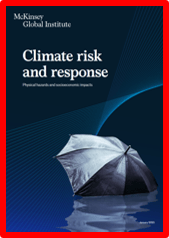
January 2020
Climate risk and response. Physical hazards and socioeconomic impacts.
Pub: McKinsey Global Institute. (english text, 144 pages)
In this report, we look at the physical effects of our changing climate. We explore risks today and over the next three decades and examine cases to understand the mechanisms through which physical climate change leads to increased socioeconomic risk. We also estimate the probabilities and magnitude of potential impacts. Our aim is to help inform decision makers around the world so that they can better assess, adapt to, and mitigate the physical risks of climate change. The Authors of this report are: Jonathan Woetzel, Shanghai; Dickon Pinner, San Francisco; Hamid Samandari, New York; Hauke Engel, Frankfurt; Mekala Krishnan, Boston; Brodie Boland, Washington DC; Carter Powis, Toronto.
+++
In questo rapporto, esaminiamo gli effetti fisici del nostro clima che cambia. Esploriamo i rischi oggi e nei prossimi tre decenni ed esaminiamo i casi per comprendere i meccanismi attraverso i quali il cambiamento climatico fisico porta ad un aumento del rischio socioeconomico. Stimiamo anche le probabilità e l'entità dei potenziali impatti. Il nostro obiettivo è di aiutare a informare i decisori di tutto il mondo in modo che possano valutare, adattarsi e mitigare meglio i rischi fisici dei cambiamenti climatici. Gli autori di questo rapporto sono: Jonathan Woetzel, Shanghai; Dickon Pinner, San Francisco; Hamid Samandari, New York; Hauke Engel, Francoforte; Mekala Krishnan, Boston; Brodie Boland, Washington DC; Carter Powis, Toronto.
https://www.mckinsey.com/~/media/McKinsey/Business%20Functions/Sustainability/Our%20Insights/Climate%20risk%20and%20response%20Physical%20hazards%20and%20socioeconomic%20impacts/MGI-Climate-risk-and-response-vF.ashx
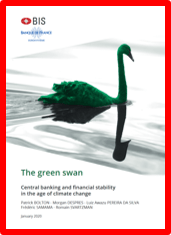
January 2020
The green swan. Central banking and financial stability in the age of climate change.
Pub: Bank for International Settlements (english text, 115 pages)
Aut: Patrick Bolton, Morgan Despres, Luiz Awazu Pereira Da Silva, Frédéric Samama, Romain Svartzman
Climate change poses new challenges to central banks, regulators and supervisors. This book reviews ways of addressing these new risks within central banks’ financial stability mandate. Traditional backward-looking risk assessments and existing climate-economic models cannot anticipate accurately enough the form that climate-related risks will take. These include what we call “green swan” risks: potentially extremely financially disruptive events that could be behind the next systemic financial crisis. Central banks have a role to play in avoiding such an outcome, including by seeking to improve their understanding of climaterelated risks through the development of forward-looking scenario-based analysis. Central banks can therefore have an additional role to play in helping coordinate the measures to fight climate change. Those include climate mitigation policies such as carbon pricing, the integration of sustainability into financial practices and accounting frameworks, the search for appropriate policy mixes, and the development of new financial mechanisms at the international level.
+++
I cambiamenti climatici rappresentano nuove sfide per le banche centrali, i regolatori e le autorità di vigilanza. Questo Rapporto esamina i modi per affrontare questi nuovi rischi nell'ambito del mandato di stabilità finanziaria delle banche centrali. Le tradizionali valutazioni del rischio e i modelli climatici esistenti non possono prevedere con sufficiente precisione la forma che assumeranno i rischi legati al clima. Questi includono quelli che chiamiamo rischi del "cigno verde": eventi potenzialmente estremamente distruttivi dal punto di vista finanziario che potrebbero essere alla base della prossima crisi finanziaria sistemica. Questo complesso problema di azione collettiva richiede il coordinamento di azioni tra molti attori tra cui governi, settore privato, società civile e comunità internazionale. Le banche centrali possono quindi svolgere un ruolo aggiuntivo nel contribuire a coordinare le misure per combattere i cambiamenti climatici. Tra questi figurano politiche di mitigazione del clima come la tariffazione del carbonio, l'integrazione della sostenibilità nelle pratiche finanziarie e nei quadri contabili, la ricerca di opportuni mix di politiche e lo sviluppo di nuovi meccanismi finanziari a livello internazionale.
https://www.bis.org/publ/othp31.pdf

30 gennaio 2020
Welfare Aziendale. 2° Rapporto Censis-Eudaimon
Pub: Censis-Eudaimon (testo italiano, 42 pagine)
Dallo studio emerge che sono i lavoratori a dichiarare un impatto positivo del welfare aziendale sull’engagement, inteso come senso di appartenenza, di coinvolgimento e di identificazione con l’azienda, che si esplicita in un clima di benessere e di miglioramento della qualità della vita: Il 57% dei lavoratori intervistati beneficiari di piani di welfare, parla in modo positivo dell’azienda presso cui lavora, sia dentro che fuori dall’organizzazione stessa; Il 51% dei lavoratori dichiara di avere una propensione minore a cambiare azienda; Il 45% dei lavoratori assicura di avere un sentimento di appartenenza nei confronti dell’azienda sempre maggiore. Complessivamente, il 76% dei lavoratori afferma l’impatto positivo del welfare sulla vita aziendale di tutti i giorni.
+++
The Report shows that it is workers who declare a positive impact of corporate welfare on engagement, understood as a sense of belonging, involvement and identification with the company, which is expressed in a climate of well-being and improvement in the quality of life: 57% of the workers interviewed who are beneficiaries of welfare plans, speak positively of the company where they work, both inside and outside the organization itself; 51% of workers say they have a lesser propensity to change companies; 45% of workers ensure that they have a growing sense of belonging towards the company. Overall, 76% of workers say the positive impact of welfare on everyday business life.
https://eudaimon.it/it/blog/2-rapporto-censis-eudaimon-sul-welfare-aziendale/

29 gennaio 2020
Italia: Commissione Affari Europei della Camera dei Deputati
Pub: ASvis (testo italiano, 31 slides)
Il Portavoce dell’Alleanza Italiana per lo Sviluppo Sostenibile (ASviS), Enrico Giovannini, all’audizione presso la Commissione Affari Europei della Camera dei Deputati, ha illustrato la situazione in funzione della governance stabilita dalla nuova Commissione dell’Unione Europea per attuare l’Agenda 2030 delle Nazioni Unite. Giovannini ha dichiarato: “Il raggiungimento degli Obiettivi dell’Agenda 2030 è ancora lontano e occorre agire in modo determinato perché i prossimi anni saranno decisivi per il nostro futuro. La grande sfida è rendere coerenti le politiche a livello europeo e nazionali. In questa direzione va la struttura della nuova Commissione Europea e le sue priorità: questo cambio di impostazione impone anche all’Italia un cambiamento nelle regole con cui si programmano e si rendono coerenti le politiche economiche, sociali e ambientali a partire dal prossimo Decreto Economia e Finanza”.
+++
The spokesman of the Italian Alliance for Sustainable Development (ASviS), Enrico Giovannini, at the hearing at the European Affairs Commission of the Italian Chamber of Deputies, illustrated the situation according to the governance established by the new Commission of the European Union to implement the United Nations 2030 Agenda. Giovannini said: "The achievement of the 2030 Agenda Goals is still far away and we need to act in a determined way because the next few years will be decisive for our future. The big challenge is to make policies coherent at European and national level. The structure of the new European Commission and its priorities goes in this direction: this change of approach also requires Italy to change the rules with which economic, social and environmental policies are planned and made coherent starting from the next DEF (Italian Economic Decree and Finance)".
https://asvis.it/public/asvis2/files/Audizione29gennaio2019.pdf
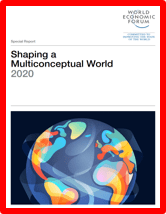
January 22, 2020
Shaping a Multiconceptual World
Pub: World Economic Forum (english text, 78 pages)
Aut: Børge Brende, John R. Allen, Yoichi Funabashi, Enrique García, Jane Harman
In the report’s opening chapter, “The Expansion of Geopolitics”, World Economic Forum President Børge Brende argues the number of actors exerting geopolitical influence is growing and domains for geopolitical competition or cooperation are also expanding. Within this context, Brende calls for a cooperative order: “The more powers compete and pursue strategic advantage at the expense of addressing shared technological, environmental and economic challenges, the more likely it will be that a broader sense of friction will develop across the global system. A rivalrous global system will in turn make it more unlikely that shared priorities are fulfilled.” “As the world becomes even more interconnected in terms of flows of information, capital and people, states will be more reliant on one another to realize positive outcomes for themselves and the global community,” Brende writes. “At a time when power dynamics are in flux, there is an opportunity for stakeholders to make the decision to shape geopolitics in a cooperative, rather than competitive, manner.”
+++
Nel capitolo di apertura del rapporto, "L'espansione della geopolitica", il presidente del Forum economico mondiale Børge Brende sostiene che il numero di attori che esercitano influenza geopolitica è in crescita e che si stanno espandendo anche i domini per la concorrenza o la cooperazione geopolitica. In questo contesto, Brende chiede un ordine cooperativo: “Più poteri competono e perseguono un vantaggio strategico per affrontare le sfide tecnologiche, ambientali ed economiche condivise, più è probabile che si svilupperà un più ampio senso di attenzione in tutto il sistema-mondo. Un sistema globale rivale a sua volta renderà più improbabile che vengano soddisfatte le priorità condivise". "Man mano che il mondo diventerà ancora più interconnesso in termini di flussi di informazioni, capitali e persone, gli Stati faranno più affidamento l'uno sull'altro per realizzare risultati positivi per sè stessi e la comunità globale", scrive Brende. "In un momento in cui le dinamiche di potere sono in evoluzione, c'è un'opportunità per le parti interessate di prendere la decisione di modellare la geopolitica in modo cooperativo, piuttosto che competitivo."
http://www3.weforum.org/docs/WEF_Shaping_a_Multiconceptual_World_2020.pdf
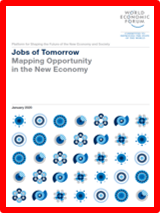
January 22, 2020
Jobs of Tomorrow: Mapping Opportunity in the New Economy
Pub: World Economic Forum (english text, 29 pages)
Through new data sources, we can gain unprecedented insights into emerging opportunities for employment in the global economy, and granular understanding of the skill sets needed by professionals. This new data reveals that 96 jobs across seven professional clusters are fast emerging in tandem reflecting “digital” and “human” factors driving growth in the professions of tomorrow. The jobs of the future are set to grow by 51% in the horizon up to 2020 and we project they will present 6.1 million job opportunities globally. These reflect the adoption of new technologies—giving rise to greater demand for Green Economy jobs, roles at the forefront of the Data and AI economy as well as new roles in Engineering, Cloud Computing, and Product Development. The growth and absolute scale of these opportunities will be distinctively determined by the choices and investments made by governments today. This report demonstrates that we have at our fingertips tools that offer unprecedented, granular insight into the nature of opportunity in the labour market. The emerging imperative is to use such tools wisely and in the service of workers in their quest for productive, fulfilling employment.
+++
Attraverso nuove fonti di dati, possiamo ottenere informazioni senza precedenti sulle opportunità emergenti per l'occupazione nell'economia globale e una comprensione granulare delle competenze necessarie ai professionisti. Questi nuovi dati rivelano che 96 posti di lavoro in sette cluster professionali stanno rapidamente emergendo in tandem, riflettendo fattori "digitali" e "umani" che guidano la crescita nelle professioni di domani. I posti di lavoro del futuro cresceranno del 51% fino al 2020 e prevediamo che presenteranno 6,1 milioni di opportunità di lavoro a livello globale. Questo riflette l'adozione di nuove tecnologie, dando origine a una maggiore domanda di posti di lavoro nella Green Economy, ruoli all'avanguardia nell'economia dei dati e dell'intelligenza artificiale, nonché nuovi ruoli in ingegneria, cloud computing e sviluppo del prodotto. La crescita e la portata assoluta di queste opportunità saranno determinate dalle scelte e dagli investimenti fatti oggi dai governi. Questo rapporto dimostra che abbiamo a portata di mano strumenti che offrono una visione senza precedenti sulla natura delle opportunità nel mercato del lavoro. L'imperativo emergente è usare saggiamente e al servizio dei lavoratori tali strumenti nella loro ricerca di occupazione produttiva e soddisfacente.
http://www3.weforum.org/docs/WEF_Jobs_of_Tomorrow_2020.pdf
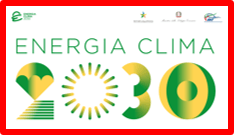
21 gennaio 2020
Piano nazionale integrato per l’energia e il clima (Pniec)
Pub: Ministero dello sviluppo economico –Italia (MISE) (testo italiano, 294 pagine, slides 38 pagine)
Con il Piano Nazionale Integrato per l’Energia e il Clima vengono stabiliti gli obiettivi nazionali al 2030 sull’efficienza energetica, sulle fonti rinnovabili e sulla riduzione delle emissioni di CO2, nonché gli obiettivi in tema di sicurezza energetica, interconnessioni, mercato unico dell’energia e competitività, sviluppo e mobilità sostenibile, delineando per ciascuno di essi le misure che saranno attuate per assicurarne il raggiungimento. L’attuazione del Piano sarà assicurata dai decreti legislativi di recepimento delle direttive europee in materia di efficienza energetica, di fonti rinnovabili e di mercati dell’elettricità e del gas, che saranno emanati nel corso del 2020.
+++
With the Italian Integrated National Plan for Energy and Climate, the national targets for 2030 on energy efficiency, renewable sources and the reduction of CO2 emissions are established, as well as the objectives in terms of energy security, interconnections, single market of energy and competitiveness, development and sustainable mobility, outlining for each of them the measures that will be implemented to ensure their achievement. The implementation of the Plan will be ensured by legislative decrees transposing European directives on energy efficiency, renewable sources and electricity and gas markets, which will be issued during 2020.
https://www.mise.gov.it/images/stories/documenti/PNIEC_finale_17012020.pdf
https://www.mise.gov.it/images/stories/documenti/WEB_ENERGIACLIMA2030.pdf

January 20, 2020
The Future 100
Pub: Wunderman Thompson Intelligence. (english text, 262 pages)
The report on Trends and Change to Watch in 2020 highlights emerging consumer behaviors with 100 trend predictions. Trends span culture, tech and innovation, travel and hospitality, brands and marketing, food and drink, beauty, retail, health, luxury and finance. Each includes an original analysis of why it matters for the organizations whose products and services we use daily. The turn of this new decade is proving a key marker for positive change as consumers and companies are desperate to look beyond the latter part of the 2010s, which was filled with political, economic and environmental instability. People are now banding together, resulting in increased global action and the untabooing of social norms. The reign of Big Tech is coming to an end and companies and figureheads are being held accountable for wider social and environmental issues. For 2020 ethically motivated consumers have created a new value system for brands, one that protects consumers, preserves culture and provides hope (see optimistic futures, p6). They are also inspiring improvements to existing environmental promises.
+++
Il Rapporto sulle tendenze e cambiamenti da tenere d'occhio nel 2020 evidenzia i comportamenti emergenti dei consumatori con 100 previsioni di tendenza. Le tendenze abbracciano cultura, tecnologia e innovazione, viaggi e ospitalità, marchi e marketing, cibo e bevande, bellezza, vendita al dettaglio, salute, lusso e finanza. Ciascuno include un'analisi originale dell’importanza per le organizzazioni i cui prodotti e servizi utilizziamo quotidianamente. La svolta di questo nuovo decennio si sta dimostrando un indicatore chiave per un cambiamento positivo poiché i consumatori e le aziende sono delusi degli ultimi anni, che sono stati di instabilità politica, economica e ambientale. Gli individui ora stanno convergendo, dando luogo a una crescita di azioni globali e all'instaurazione di norme sociali. Il regno di Big Tech sta volgendo al termine e le società sono ritenute responsabili per le più grandi questioni sociali e ambientali. Per il 2020 i consumatori eticamente motivati hanno creato un nuovo sistema di valori per i marchi, che protegga i consumatori, preservi la cultura e fornisca speranza.
https://www.jwtintelligence.com/trend-reports/the-future-100-2020/
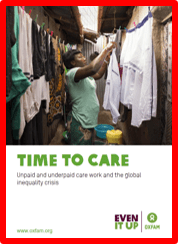
January 20, 2020
Time to care
Pub: Oxfam International (english text, 63 pages)
Aut: Max Lawson, Anam Parvez Butt, Rowan Harvey, Diana Sarosi, Clare Coffey, Kim Piaget, Julie Thekkudan
Economic inequality is out of control. In 2019, the world’s billionaires, only 2,153 people, had more wealth than 4.6 billion people. This great divide is based on a flawed and sexist economic system that values the wealth of the privileged few, mostly men, more than the billions of hours of the most essential work – the unpaid and underpaid care work done primarily by women and girls around the world. Tending to others, cooking, cleaning, fetching water and firewood are essential daily tasks for the wellbeing of societies, communities and the functioning of the economy. The heavy and unequal responsibility of care work perpetuates gender and economic inequalities. This has to change. Governments around the world must act now to build a human economy that is feminist and values what truly matters to society, rather than fuelling an endless pursuit of profit and wealth. Investing in national care systems to address the disproportionate responsibility for care work done by women and girls and introducing progressive taxation, including taxing wealth and legislating in favour of carers, are possible and crucial first steps.
+++
La disuguaglianza economica è fuori controllo. Nel 2019, i miliardari del mondo, solo 2.153 persone, avevano più ricchezza di 4,6 miliardi di persone. Questa grande divisione si basa su un sistema economico imperfetto e sessista che valorizza la ricchezza di pochi privilegiati, soprattutto uomini, più che i miliardi di ore del lavoro più essenziale: il lavoro di assistenza non retribuito e sottopagato svolto principalmente da donne e ragazze intorno al mondo. Prendersi cura degli altri, cucinare, pulire, recuperare acqua e legna da ardere sono compiti quotidiani essenziali per il benessere delle società, delle comunità e del funzionamento dell'economia. La pesante e diseguale responsabilità del lavoro di cura perpetua le disparità economiche e di genere. Questo deve cambiare. I governi di tutto il mondo devono agire ora per costruire un'economia umana femminista e valorizzare ciò che conta davvero per la società, piuttosto che alimentare una continua ricerca di profitto e ricchezza. Investire nei sistemi di assistenza nazionali per affrontare la responsabilità sproporzionata per il lavoro di cura svolto da donne e ragazze e introdurre una tassazione progressiva, inclusa la tassazione della ricchezza e legiferare a favore degli assistenti, sono possibili e primi passi cruciali.
https://oxfamilibrary.openrepository.com/bitstream/handle/10546/620928/bp-time-to-care-inequality-200120-en.pdf
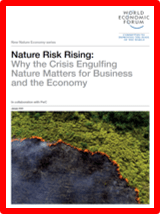
January 19, 2020
Nature Risk Rising: Why the Crisis Engulfing Nature Matters for Business and the Economy
Pub: World Economic Forum (english text, 36 pages)
Nature Risk Rising, produced in collaboration with PwC and the first report in the NNE series, explains how nature-related risks matter to business, why they must be urgently mainstreamed into risk management strategies and why it is vital to prioritize the protection of nature’s assets and services within the broader global economic growth agenda. Nature loss is a planetary emergency. Humanity has already wiped out 83% of wild mammals and half of all plants and severely altered three-quarters of ice-free land and two-thirds of marine environments. One million species are at risk of extinction in the coming decades – a rate tens to hundreds of times higher than the average over the past 10 million years. We have the power to change this. Humanity urgently needs to rethink its relationship with nature, in order to halt and reverse the alarming degradation of the natural world. Business leaders have a crucial role to play, by putting nature at the core of their processes and decision-making and systematically identifying, assessing, mitigating and disclosing nature-related risks to avoid severe consequences. Businesses can be part of the global movement to protect and restore nature.
+++
Nature Risk Rising, prodotto in collaborazione con PwC e il primo rapporto della serie NNE, spiega in che modo i rischi legati alla natura sono importanti per le aziende, perché devono essere urgentemente integrati nelle strategie di gestione dei rischi e perché è fondamentale dare priorità alla protezione delle risorse naturali e servizi nell'ambito del più ampio programma di crescita economica globale. La perdita della natura è un'emergenza planetaria. L'umanità ha già spazzato via l'83% dei mammiferi selvatici e la metà di tutte le piante e ha gravemente modificato i tre quarti delle terre prive di ghiaccio e i due terzi degli ambienti marini. Un milione di specie sono a rischio di estinzione nei prossimi decenni - un tasso che va dalle decine a centinaia di volte superiore alla media degli ultimi 10 milioni di anni. Abbiamo il potere di cambiare questo. L'umanità ha urgente bisogno di ripensare il suo rapporto con la natura, al fine di arrestare e invertire l'allarmante degrado del mondo naturale. I dirigenti aziendali hanno un ruolo cruciale da svolgere, mettendo la natura al centro dei loro processi e processi decisionali e identificando, valutando, mitigando e divulgando sistematicamente i rischi legati alla natura per evitare gravi conseguenze. Le aziende possono far parte del movimento globale per proteggere e ripristinare la natura.
http://www3.weforum.org/docs/WEF_New_Nature_Economy_Report_2020.pdf

18 gennaio 2020
Tech Trend 2020
Pub: Key4Biz. (testo italiano, 56 pagine)
Nel corso del 2019, il termine più usato (e forse in qualche modo abusato) è stato quello dell’Intelligenza Artificiale (IA), assieme ad altri termini come 5G, Blockchain, Machine learning, Quantum computing, ma a farla da padrone sono stati i tradizionali campi operativi dell’economia digitale, molti dei quali ormai giunti ad un livello di piena maturità. Nei Tech Trend 2020 sono distinte le aree tecnologiche in paragrafi, anche se è ben noto il livello di interdipendenza e sovrapposizione funzionale di molte tecnologie. Da sottolineare come al cuore del sistema, anche in questo 2020 appena iniziato, non vi sarà la tecnologia, ma le persone. Il 2020 sarà anche un anno forse cruciale nel giro di boa della definitiva condivisione ed internazionalizzazione del futuro. La parola d’ordine sarà l’interdipendenza e le soluzioni ai problemi crescenti del mondo non potranno essere assunte da un solo Paese.
+++
During 2019, the most used (and perhaps somewhat abused) term was that of Artificial Intelligence (AI), together with other terms such as 5G, Blockchain, Machine learning, Quantum computing, but they were the masters the traditional fields of operation of the digital economy, many of which have now reached a level of full maturity. In the Tech Trends 2020, the technological areas are divided into paragraphs, although the level of interdependence and functional overlap of many technologies is well known. To underline how at the heart of the system, even in this 2020 that has just started, there will be no technology, but people. 2020 will also be a perhaps crucial year in the turning point of the definitive sharing and internationalization of the future. The watchword will be interdependence and the solutions to the world's growing problems cannot be taken by a single Country.
https://www.key4biz.it/wp-content/uploads/2020/01/TECH-TREND-2020-DEF.pdf
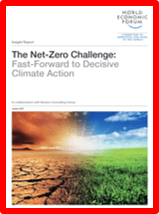
January 17, 2020
The Net-Zero Challenge: Fast-Forward to Decisive Climate Action
Pub: World Economic Forum (english text, 41 pages)
The report examines the current state of global climate action by companies and governments, providing a clear way forward. Climate action is first and foremost an opportunity for countries and businesses to build a competitive advantage. The findings for this report are based on quantitative and qualitative assessments of governments, corporations, investors and societies. We conducted interviews with 13 climate experts and 24 CEOs and executives of leading companies across all sectors – from energy and industrial firms with high direct emissions, to technology, service and consumer businesses with significant influence over the emissions of their supply chains and products. We analysed corporate data from CDP, a non-governmental organization that collates voluntary emissions disclosures from nearly 7,000 large companies, monitors global emissions and assesses policy frameworks from governments. Our analysis was supplemented with additional research from the Energy Transitions Commission (Mission Possible), International Energy Agency, Intergovernmental Panel on Climate Change, United Nations Environment Programme, Climate Action Tracker and World Resources Institute, as well as previous work by Boston Consulting Group.
+++
Il rapporto esamina lo stato attuale dell'azione globale sul clima da parte di aziende e governi, fornendo una chiara via da seguire. L'azione per il clima è innanzitutto un'opportunità per i Paesi e le imprese di costruire un vantaggio competitivo. I risultati di questo rapporto si basano su valutazioni quantitative e qualitative di governi, corporazioni, investitori e società. Abbiamo condotto interviste con 13 esperti del clima e 24 amministratori delegati e dirigenti di aziende leader in tutti i settori - dalle aziende energetiche e industriali ad alte emissioni dirette, alle tecnologie, ai servizi e alle imprese di consumo con un'influenza significativa sulle emissioni delle loro catene di approvvigionamento e prodotti. Abbiamo analizzato i dati aziendali da CDP, un'organizzazione non governativa che raccoglie informazioni sulle emissioni volontarie da quasi 7000 grandi aziende, monitora le emissioni globali e valuta i quadri politici dei governi. La nostra analisi è stata integrata con ulteriori ricerche di Energy Transitions Commission (Mission Possible), International Energy Agency, Intergovernmental Panel on Climate Change, United Nations Environment Programme, Climate Action Tracker and World Resources Institute, nonché precedenti lavori del Boston Consulting Group.
http://www3.weforum.org/docs/WEF_The_Net_Zero_Challenge.pdf

January 16, 2020
World Economic Situation and Prospects 2020
Pub: United Nations - Department of Economic and Social Affairs. (english text, 236 pages)
The global economy has suffered a significant slowdown amid prolonged trade disputes and wide-ranging policy uncertainties. While a slight uptick in economic activity is forecast for 2020, the World Economic Situation and Prospects 2020 warns that economic risks remain strongly tilted to the downside, aggravated by deepening political polarization and increasing scepticism over the benefits of multilateralism. These risks could inflict severe and long-lasting damage on development prospects. Compounding the economic slowdown, rising global temperatures and the increasing frequency and intensity of weather-related shocks press home the urgent need for a dramatic shift in the global energy mix. The ‘World Economic Situation and Prospects 2020 ‘explores the global economic implications of this energy transition. The transition to a cleaner energy mix will bring not only environmental and health benefits, but economic opportunities for many. However, without appropriate policy strategies, the costs and benefits will be unevenly distributed within and between countries.
+++
L'economia globale ha subito un significativo rallentamento tra controversie commerciali prolungate e incertezze politiche di ampio respiro. Mentre è previsto un leggero incremento dell'attività economica per il 2020, la situazione economica mondiale e le prospettive 2020 avvertono che i rischi rimangono aggravati dall'approfondimento della polarizzazione politica e dal crescente scetticismo sui benefici del multilateralismo. Questi rischi potrebbero causare danni gravi e di lunga durata alle prospettive di sviluppo. Il peggioramento del rallentamento economico, l'aumento delle temperature globali e l'aumento della frequenza e dell'intensità degli shock meteorologici confermano l'urgente necessità di un drammatico cambiamento nel mix energetico globale. Il rapporto esplora le implicazioni economiche globali di questa transizione energetica. La transizione verso un mix energetico più pulito porterà non solo benefici ambientali e sanitari, ma opportunità economiche per molti. Tuttavia, senza adeguate strategie politiche, i costi e i benefici saranno distribuiti in modo disomogeneo all'interno dei Paesi e tra di essi.
https://www.un.org/development/desa/dpad/wp-content/uploads/sites/45/WESP2020_FullReport.pdf
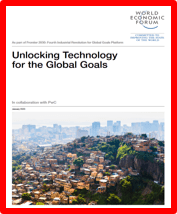
January 16, 2020
Unlocking Technology for the Global Goals
Pub: World Economic Forum (english text, 48 pages)
The Fourth Industrial Revolution (4IR) is still in its early years yet it is already changing the way we work, live and interact. As 4IR technologies become faster, smarter, and more widely applied, the pace of transformation will only accelerate. In parallel, we face global challenges of increasing magnitude and immediacy. The United Nation’s 17 Global Goals give a blueprint for what we globally and collectively must do if we are to end extreme poverty, protect our natural environment, revert climate change and create a more sustainable, equal and prosperous future for all. Despite a rapid rise of 4IR technologies being applied across many aspects of industry and commerce, the potential of these technologies to accelerate progress to the Global Goals is not being realised. In this report, developed in collaboration with PwC, we showcase the significant opportunity to harness new technologies for the Global Goals. Through analysis of over 300 technology applications, the report explores; 1) the extent to which this opportunity is being realised, 2) the barriers to scaling these applications, and 3) the enabling framework for unlocking this opportunity.
+++
La quarta rivoluzione industriale (4IR) è ancora nei suoi primi anni, ma sta già cambiando il modo di lavorare, vivere e interagire. Man mano che le tecnologie 4IR diventano più veloci, più intelligenti e più ampiamente applicate, il ritmo della trasformazione non farà che accelerare. Parallelamente, affrontiamo sfide globali di grandezza e immediatezza crescenti. I 17 obiettivi globali delle Nazioni Unite forniscono un piano per ciò che dobbiamo fare globalmente e collettivamente se vogliamo porre fine alla povertà estrema, proteggere il nostro ambiente naturale, ripristinare i cambiamenti climatici e creare un futuro più sostenibile, equo e prospero per tutti. Nonostante un rapido aumento delle tecnologie 4IR sia applicato a molti aspetti dell'industria e del commercio, il potenziale di queste tecnologie per accelerare il progresso verso gli Obiettivi globali non viene realizzato. In questo rapporto, sviluppato in collaborazione con PwC, mostriamo la significativa opportunità di sfruttare le nuove tecnologie per gli obiettivi globali. Attraverso l'analisi di oltre 300 applicazioni tecnologiche, il rapporto esplora; 1) la misura in cui questa opportunità si sta realizzando, 2) gli ostacoli alla scalabilità di queste applicazioni e 3) il quadro abilitante per sbloccare questa opportunità.
http://www3.weforum.org/docs/Unlocking_Technology_for_the_Global_Goals.pdf
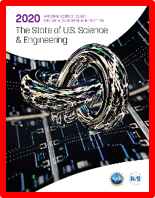
January 15, 2020
The State of U.S. Science & Engineering. 2020 Science & Engineering Indicators
Pub: National Science Board (english text, 32 pages)
The State of U.S. Science and Engineering does not forecast future outcomes, the data clearly show the evolution of the United States in the global S&E enterprise. Increasingly, the United States is seen globally as an important leader rather than the uncontested leader. Whether and how long the current global trends continue is an important question that will be affected by the overall S&E environment, along with the economic, social, and political forces that shape the S&E environment in the United States and around the world.
+++
Lo ‘Stato della Scienza e dell‘Ingegneria degli Stati Uniti (S&E)’ non prevede risultati futuri, i dati mostrano chiaramente l'evoluzione degli Stati Uniti nell'impresa globale S&E. Sempre più spesso, gli Stati Uniti sono visti a livello globale come un leader importante piuttosto che il leader incontestato. Se e per quanto tempo continueranno le attuali tendenze globali è una domanda importante che sarà influenzata dall'ambiente S&E complessivo, insieme alle forze economiche, sociali e politiche che modellano l'ambiente S&E negli Stati Uniti e nel mondo.
https://ncses.nsf.gov/pubs/nsb20201/executive-summary

January 15, 2020
The Global RisksReport 2020
Pub: World Economic Forum. (english text, 102 pages)
The 15th edition of the World Economic Forum’s Global Risks Report is published as critical risks are manifesting. The global economy is facing an increased risk of stagnation, climate change is striking harder and more rapidly than expected, and fragmented cyberspace threatens the full potential of next-generation technologies — all while citizens worldwide protest political and economic conditions and voice concerns about systems that exacerbate inequality. The challenges before us demand immediate collective action, but fractures within the global community appear to only be widening. Stakeholders need to act quickly and with purpose within an unsettled global landscape.
+++
La 15a edizione del Rapporto sui rischi globali del World Economic Forum viene pubblicata quando si manifestano rischi critici. L'economia globale sta affrontando un aumentato rischio di stagnazione, i cambiamenti climatici stanno colpendo più duramente e più rapidamente del previsto, e il cyberspazio frammentato minaccia il pieno potenziale delle tecnologie di prossima generazione, il tutto mentre i cittadini di tutto il mondo protestano contro le condizioni politiche ed economiche e esprimono preoccupazioni per i sistemi che esacerbano la disuguaglianza. Le sfide che ci attendono richiedono un'azione collettiva immediata, ma le fratture all'interno della comunità globale sembrano solo allargarsi. Le parti interessate devono agire rapidamente e con uno scopo all'interno di un panorama globale instabile.
http://www3.weforum.org/docs/WEF_Global_Risk_Report_2020.pdf

January 10, 2020
Tech Distribution 2025
Pub: Global Technology Distribution Council (GTDC). (english text, 14 pages)
The GTDC commissioned Vation to research and develop this report due to the firm’s unique perspective on key participants in the IT value chain, from venture capitalists and OEMs – including emerging and established vendor partners – to the central role of distributors, the solution providers they serve and, of course, end customers. This is the GTDC’s first report to look at all of these dimensions to channel business and what to expect from distributors in the years ahead. In addition to conducting in-depth interviews with leaders from all dimensions of the technology ecosystem, Vation gathered detailed survey responses from more than 50 top executives on the most important drivers for distribution partnership success today and expectations over the next five years.
+++
Il Comitato di Distribuzione Tecnologica Globale (GTDC) ha commissionato a Vation la ricerca e lo sviluppo di questo rapporto per studiare la prospettiva dei principali partecipanti alla catena del valore IT, compresi i partner di fornitori emergenti fino al ruolo centrale dei distributori, i fornitori di soluzioni utili e naturalmente i clienti finali. Questo è il primo rapporto del GTDC per esaminare tutte queste dimensioni, per incanalare il business e prevedere che cosa aspettarsi dai distributori negli anni a venire. Oltre a condurre interviste approfondite con i leader di tutti i settori della tecnologia di ecosistema, Vation ha raccolto risposte dettagliate al sondaggio da oltre 50 top executive sui principali driver per il successo della partnership distributiva oggi e le aspettative per i prossimi cinque anni.
https://gtdc.org/wp-content/uploads/2019/11/GTDC-Report_Tech-Distribution-2025-1.pdf

January 9, 2020
Global Economic Prospects. Slow Growth, Policy Challenges.
Pub: The World Bank Group. (english text, 334 pages)
Global growth is expected to edge up to 2.5 percent in 2020—up slightly from the post-crisis low of 2.4 percent registered last year—as trade and investment gradually recover. The recovery in global growth will reflect an expected pickup in emerging market and developing economies (EMDEs), which are projected to grow 4.1 percent this year. However, this will largely depend on a rebound in a small number of large EMDEs, most of which are emerging from deep recessions or sharp slowdowns. While growth could be stronger if reduced trade tensions lead to a sustained reduction in uncertainty, the balance of risks is to the downside. In an environment of limited macroeconomic policy space compounded by high debt levels, EMDEs need to foster inclusive and sustainable growth by undertaking reforms to bolster governance and business climates, improve tax policy, promote trade integration, and rekindle productivity growth, while protecting vulnerable groups.
+++
Si prevede che la crescita globale raggiungerà il 2,5 per cento nel 2020, in leggero aumento rispetto al minimo post-crisi del 2,4 per cento registrato lo scorso anno, con il progressivo recupero di commercio e investimenti. La ripresa della crescita globale rifletterà una ripresa attesa nei Mercati Emergenti e nelle Economie in via di Sviluppo (EMDE), che dovrebbero crescere del 4,1 per cento quest'anno. Tuttavia, ciò dipenderà in gran parte da un rimbalzo in un piccolo numero di grandi EMDE, la maggior parte dei quali sta emergendo da profonde recessioni o bruschi rallentamenti. Mentre la crescita potrebbe essere più forte se le tensioni commerciali portassero a una riduzione sostenuta dell'incertezza, il saldo dei rischi è al ribasso. In un contesto di spazio politico macroeconomico limitato, aggravato da elevati livelli di debito, gli EMDE devono favorire la crescita inclusiva e sostenibile intraprendendo riforme per rafforzare la governance e il clima degli affari, migliorare la politica fiscale, promuovere l'integrazione commerciale e riaccendere la crescita della produttività, proteggendo nel contempo i gruppi vulnerabili .
https://www.worldbank.org/en/publication/global-economic-prospects

January 7, 2020
Recharge EU
Pub: Transport & Environment - European Federation for Transport and Environment AISBL (english text, 68 pages)
To set an effective future-proof infrastructure framework, T&E has designed a new methodology -called the Public Charging Supply metric -on how to count and mandate infrastructure deployment across the member states in the new regulation. Instead of simply counting each charge point as one, T&E’s Supply Metric proposes to weigh charge points based how much energy they can provide to the electric vehicle fleet and how available they are to the public. This metric should be used to set the EU public charging infrastructure deployment targets for each country for 2025 and 2030, corresponding to 1.3 million public charge points EU-wide in 2025 and close to 3 million in 2030. In total this would require investment of €1.8 billion in the year 2025, or only 3% of the EU’s annual investment in road transport infrastructure.
+++
Per stabilire un efficace framework infrastrutturale a prova di futuro, T&E ha progettato una nuova metodologia, chiamata Metrica di fornitura di servizi di ricarica pubblica, su come contare e imporre la distribuzione dell'infrastruttura negli Stati membri nelle nuove regolamentazioni. Invece di contare semplicemente ogni punto di ricarica come uno, la metrica di fornitura di T&E propone di ponderare i punti di ricarica in base alla quantità di energia che possono fornire alla flotta di veicoli elettrici e alla loro disponibilità al pubblico. Questa metrica dovrebbe essere utilizzata per fissare gli obiettivi di implementazione dell'infrastruttura di tariffazione pubblica dell'UE per ciascun Paese per il 2025 e il 2030, corrispondenti a 1,3 milioni di punti di ricarica pubblica in tutta l'UE nel 2025 e vicini a 3 milioni nel 2030. In totale questo richiederebbe investimenti di 1,8 miliardi di euro nell'anno 2025, ovvero solo il 3% degli investimenti annuali dell'UE nelle infrastrutture di trasporto stradale.
https://www.transportenvironment.org/sites/te/files/publications/01%202020%20Draft%20TE%20Infrastructure%20Report%20Final.pdf

